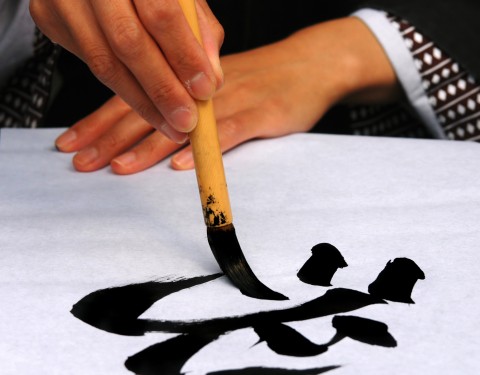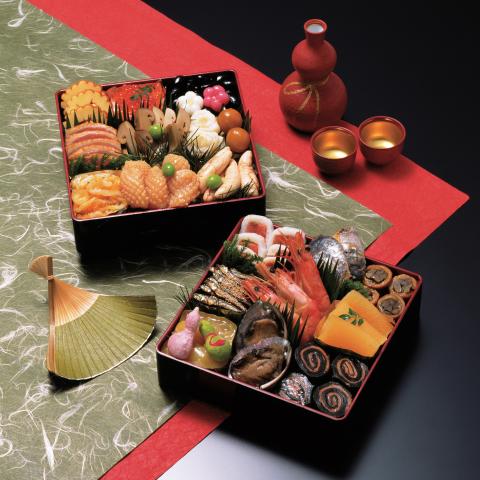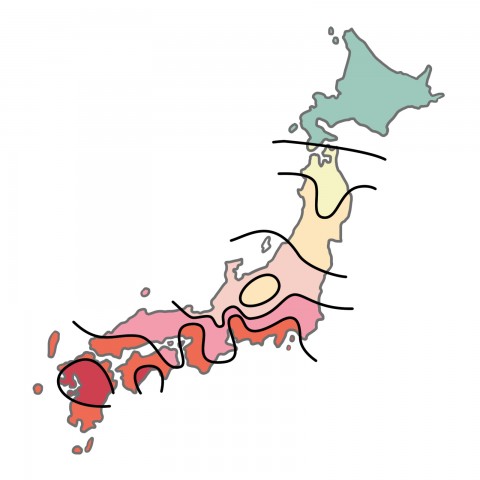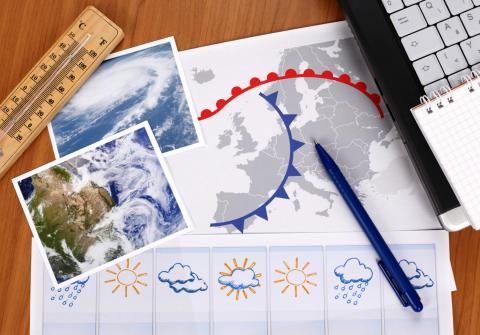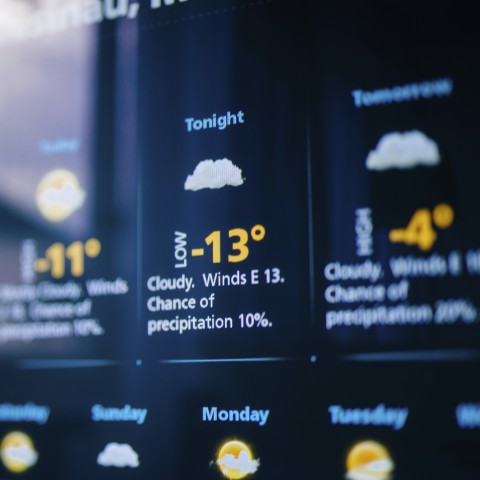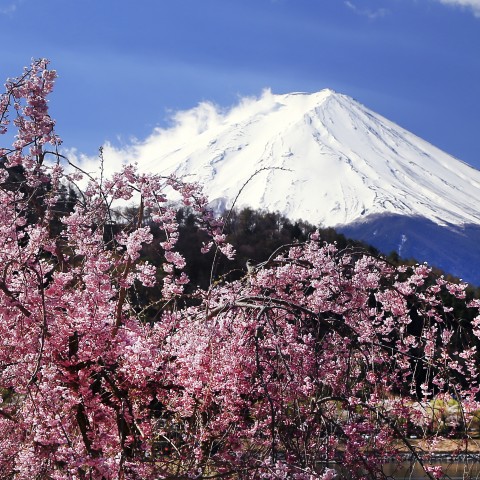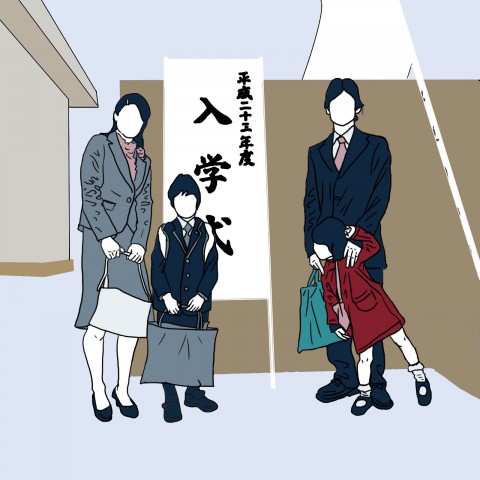
Pronouns are used to substitute nouns, such as people or things, in a sentence. Using pronouns allows you to avoid repetitive usage of a particular word in a sentence, which would sound awkward. Japanese pronouns are very different from those in English because Japanese pronouns can be omitted from a sentence when they’re implied through the context.
Unlike in English, there are many different variations of Japanese personal pronouns that translate as “I/me” and “you,” although only a few are commonly used. This expression of Japanese pronouns comes from Japanese culture, which puts importance on respect, seniority, and social order.
Each Japanese pronoun variation denotes the different characteristics of the speaker. These include gender, age, social status, level of respect, and their relationship with the person they’re speaking to.
Ready to learn Japanese pronouns? In this Japanese pronoun guide, we introduce Japanese pronouns that will boost your language skills, and teach you how to use them. JapanesePod101 makes it simple and easy to understand!
 Table of Contents
Table of Contents
- Japanese Personal Pronouns
- Japanese Demonstrative Pronouns
- Japanese Interrogative Pronouns
- Japanese Indefinite Pronouns
- Examples
- Conclusion: How JapanesePod101 Can Help You Learn More Japanese
1. Japanese Personal Pronouns

Personal pronouns in Japanese are rich in expression, and there are dozens of first- and second-person pronouns. However, most of them aren’t commonly used so we’ll introduce frequently used Japanese personal pronouns here.
1. 1st, 2nd, 3rd Person Singular
1. How to Say “I”
| Reading | Kanji | Hiragana | Level of Formality | Gender | Characteristics |
|---|---|---|---|---|---|
| watakushi | 私 | わたくし | very formal | both | Very formal and polite personal pronoun often used in very official occasions. |
| watashi | 私 | わたし | formal / informal | both | Used by both genders in formal occasions, such as at the workplace. This is the most commonly used word for “I,” but it’s often omitted in a sentence. In informal situations, this is typically used by women. |
| atashi | ー | あたし | informal | female | This is the casual version of watashi and it’s used by younger females in conversations. However, it can sound a bit childish and unsophisticated. |
| boku | 僕 | ぼく | informal | male | Used by males of all ages, but very often by kids and younger men. It gives an impression of humbleness. This can also be used as a second-person pronoun toward little boys (English equivalent: “kid”). |
| ore | 俺 | おれ | very informal | male | Frequently used by men in informal settings, such as among family and friends. It sounds very masculine. This can be very rude when it’s used in formal occasions or in front of respectable/senior people. |
2. How to Say “You”
| Reading | Kanji | Hiragana | Level of Formality | Gender | Characteristics |
|---|---|---|---|---|---|
| anata | 貴方 | あなた | formal / informal | both | This is almost equivalent to the English word “you.” However, it’s not often used as the subject in a sentence, and it’s often omitted. It’s more common to use a person’s name with a Japanese honorific, such as 様 (sama) or さん (san), to express “you” in formal contexts. In addition, wives often call their husbands by this Japanese pronoun. When used this way, it’s comparable to the English words “dear” or “darling.” Kanji is rarely used. |
| kimi | 君 | きみ | informal | both | Often used to call subordinates and peers in informal settings. It can also be affectionate and polite when used by a boyfriend/husband to call his girlfriend/wife. It’s impolite and inappropriate when used with respectable/senior people or strangers. The Kanji 君 can also be read as kun when it’s added next to a male’s name as a casual and affectionate honorific word. |
| omae | お前 | おまえ | very informal | both / male | Often used by men. It expresses that the speaker has a superior status or age, and it’s very rude to use this toward senior people and in formal settings. It’s also used among close friends to call peers. In addition, husbands frequently call their wives by this pronoun, which is comparable to the female use of anata. |
| anta | ー | あんた | very informal | both | It’s a short version of anata, but it sounds very impolite and implies a sense of contempt. It can also be used between people in a very close relationship. It’s very rude and inappropriate to use toward senior people and in formal settings. |
| kisama | 貴様 | きさま | very rude and hostile | both | The historical origin of this word was very formal, but it’s used today as a very rude way to call another person. It has a sense of extreme hostility from the speaker. You’ll often hear this in 時代劇 (jidaigeki) (samurai warrior) drama shows. |

3. How to Say “He” and “She”
Does Japanese have gendered pronouns? Sort of. Here’s what we mean:
| Reading | Kanji | Hiragana | Level of Formality |
|---|---|---|---|
| kare | 彼 | かれ | formal / informal |
| kanojo | 彼女 | かのじょ | formal / informal |
The Japanese pronouns for the third person are above. However, they’re not used like they are in English.
Native Japanese people prefer to use the person’s name, or to describe them as あの人 (ano hito), meaning “that person,” which makes it unnecessary to indicate gender.
In informal settings, 彼 (kare) means “boyfriend” and 彼女 (kanojo) means “girlfriend.”
2. 1st, 2nd, 3rd Person Plural
In order to make Japanese personal pronouns plural, a suffix is added to them.
The suffix can be ~達 (-tachi ), ~方 (-gata), or ~ら (-ra), depending on which word comes in front.
| Meaning | Suffix | Reading | Level of Formality |
|---|---|---|---|
| We | -tachi | watashi-tachi | neutral / formal |
| You [plural] | -tachi | anata-tachi | neutral / formal |
| You [plural] | -gata | anata-gata | formal |
| They [he, plural] | -ra | kare-ra | neutral / formal |
| They [she, plural] | -ra | kanojo-ra | neutral / formal |
The suffix 達 (-tachi) can be added to most of the nouns that refer to people and animals. For example, 動物達(dōbutsu-tachi) means “animals.”

3. Possessive Forms
To make Japanese possessive pronouns, add the suffix の (〜no) to the pronouns.
| Meaning | Reading |
|---|---|
| mine | watashi no |
| yours | anata no |
| his | kare no |
| hers | kanojo no |
| ours | watashi-tachi no |
| theirs | kare-ra no |
4. Reflective or Intensive Forms
To make Japanese reflexive pronouns or intensive forms, add the suffix 自身 (〜jishin) to the pronouns.
| Meaning | Reading |
|---|---|
| myself | watashi jishin |
| yourself | anata jishin |
| himself | kare jishin |
| herself | kanojo jishin |
| ourselves | watashi-tachi jishin |
| themselves | kare-ra jishin |
To hear how to pronounce Japanese pronouns, visit Most Useful Pronouns.
2. Japanese Demonstrative Pronouns
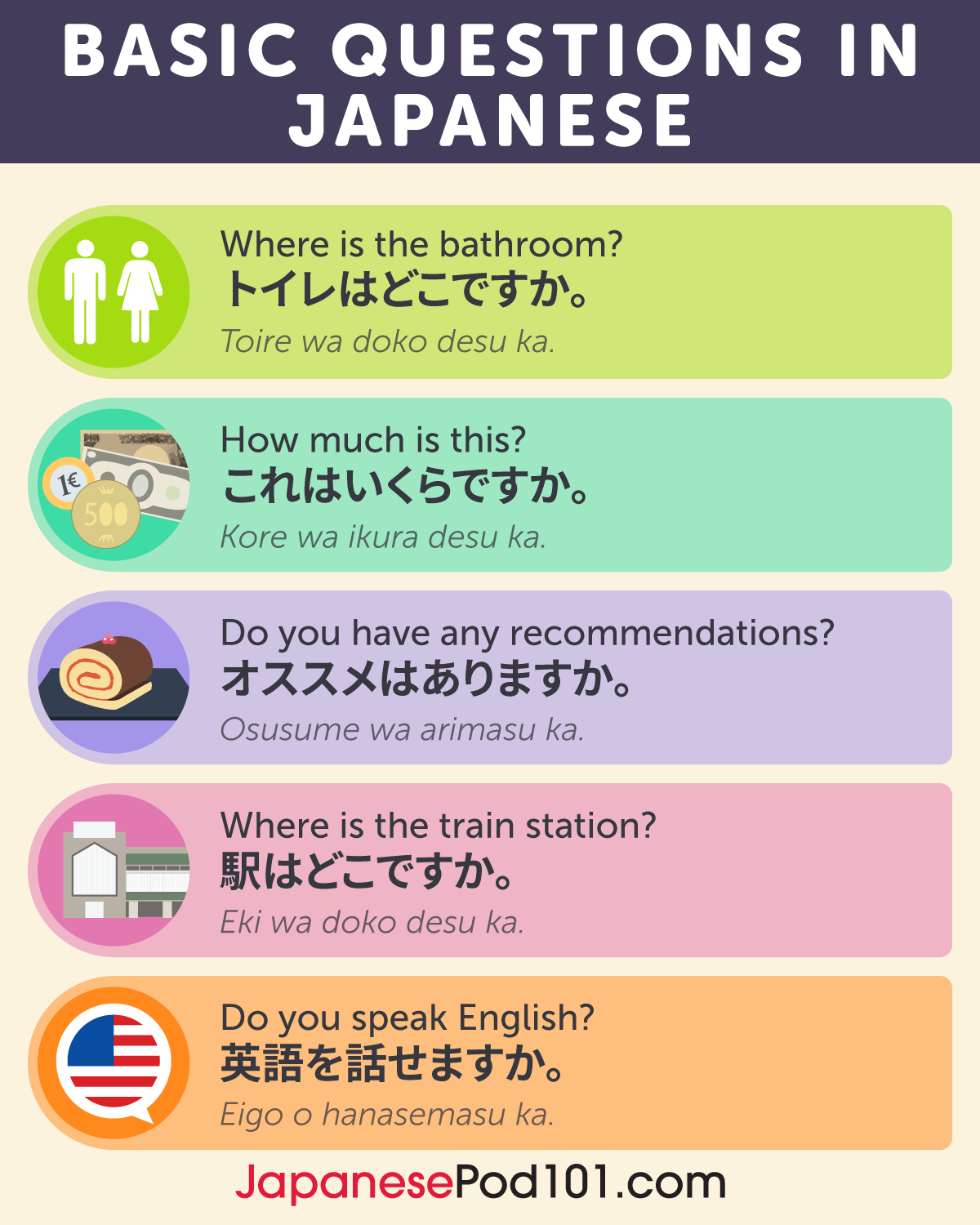
Demonstrative pronouns in Japanese are typically written in Hiragana. Further, Japanese demonstrative pronouns are easy to remember as they’re categorized in groups depending on their degree of distance from the speaker or listener.
Words that:
- begin with こ (ko-) indicate something close to the speaker.
- begin with そ (so-) indicate some distance from the speaker or something close to the listener.
- begin with あ (a-) indicate far distance.
| Meaning | Reading | Hiragana | Notes |
|---|---|---|---|
| this | kore | これ | near speaker |
| it | sore | それ | near listener |
| that | are | あれ | distant from both speaker and listener |
| these | kore-ra | これら | near speaker |
| those | sore-ra / are-ra | それら/ あれら | near listener / distant from both speaker and listener |
| here | koko | ここ | near speaker |
| there | soko | そこ | near listener |
| over there | asoko | あそこ | distant from both speaker and listener |
3. Japanese Interrogative Pronouns
Similar to demonstrative pronouns, most of the Japanese interrogative pronouns begin with ど (do-) or だ (da-).
| Meaning | Reading | Kanji | Hiragana |
|---|---|---|---|
| what | nani | 何 | なに |
| which | dono / dore | ー | どの/どれ |
| who | dare | 誰 | だれ |
| whom | dare ni | 誰に | 誰に |
| whose | dare no | 誰の | だれの |
| when | itsu | ー | いつ |
| why | naze | ー | なぜ |
Keep in mind that “whose” is a possessive form of “who,” and the rules of the Japanese possessive forms also apply:
誰 (dare) meaning “who” + の (〜no) = 誰の (dare no) meaning “whose.”

4. Japanese Indefinite Pronouns
In the Japanese language, “everyone/everybody” and “anyone/anybody” are both translated as 誰でも (dare demo) in some contexts.
In a negative sentence using indefinite pronouns such as “no one/nobody,” “nowhere,” and “nothing,” a negative form is typically: も…ない (...mo…nai …).
| Meaning | Reading | Kanji | Hiragana |
|---|---|---|---|
| everyone / everybody | minna / dare demo | 皆/誰でも | みんな/だれでも |
| everywhere | doko demo / doko ni mo | ー | どこでも/どこにも |
| everything | subete / zenbu | 全て/全部 | すべて/ぜんぶ |
| someone / somebody | dare ka | 誰か | だれか |
| somewhere | doko ka | ー | どこか |
| something | nani ka | 何か | なにか |
| no one / nobody | dare mo…nai | 誰も…ない | だれも…ない |
| nowhere | doko ni mo…nai | ー | どこにも…ない |
| nothing | nani mo…nai | 何も…ない | なにも…ない |
| anyone / anybody | dare demo | 誰でも | だれでも |
| anywhere | doko demo / doko ni mo | ー | どこでも/どこにも |
| anything | nan demo | 何でも | なんでも |

5. Examples
Now that we’ve come to the end of this Japanese pronouns list, here are some example sentences using Japanese pronouns.
1. Personal Pronouns
- あなたと私は東京出身で、彼と彼女は大阪出身です。
Anata to watashi wa Tōkyō shusshin de, kare to kanojo wa Ōsaka shusshin desu.
You and I are from Tokyo, and he and she are from Osaka.
- 年上の人に向かって「お前」や「貴様」と呼ぶことはとても失礼です。
Toshiue no hito ni mukatte “omae” ya “kisama” to yobu koto wa totemo shitsurei desu.
It is very rude to call an elder person omae and kisama.
- 私達は明日、君の誕生日会へ行きます。
Watashi-tachi wa ashita, kimi no tanjōbi kai e ikimasu.
We will go to your birthday party tomorrow.
2. Demonstrative Pronouns
- それをここに持ってきてください。
Sore o koko ni motte kite kudasai.
Please bring it here.
- これらの本はあそこの棚へ戻してください。
Kore-ra no hon wa asoko no tana e modoshite kudasai.
Please put these books back on the shelf over there.
- 彼らはここからあなたの家へ出発しました。
Kare-ra wa koko kara anata no ie e shuppatsu shimashita.
They departed to your home from here.
3. Interrogative Pronouns
- 私はなぜあそこに行かなければならないか分かりません。
Watashi wa naze aoko ni ikanakereba naranai ka wakarimasen.
I don’t understand why I have to go there.
- 誰に向かって話しているのですか。
Dare ni mukatte hanashite iru no desu ka.
To whom are you talking?
- あそこのあの靴は誰のですか。
Asoko no ano kutsu wa dare no desu ka.
Whose shoes are those there?
4. Indefinite Pronouns
- 彼女はどこかに全てを置いてきました。
Kanojo wa doko ka ni subete o oite kimashita.
She left everything somewhere.
- 誰もあのような変な服を持っていないでしょう。
Dare mo ano yō na hen na fuku o motte inai deshō.
No one would have strange clothes like that.
- 誰かが彼にここで何でも食べていいと伝えました。
Dare ka ga kare ni koko de nan demo tabete ii to tsutaemashita.
Somebody told him that he could eat anything here.
To learn more useful Japanese vocabulary, check out our 100 Adjectives and 100 Nouns articles.
6. Conclusion: How JapanesePod101 Can Help You Learn More Japanese

In this article, we introduced you to a variety of common pronouns in Japanese. By now, you should have an enhanced vocabulary and have a better idea of how to use Japanese pronouns. This is something that will definitely improve your overall Japanese language skills!
Did you learn something new from this article? Do you want to know more about Japanese grammar? Let us know in the comments section below!
If you would like to learn more about the Japanese language and other useful Japanese phrases for any situation, you’ll find more helpful content on JapanesePod101.com. We provide a variety of free lessons to help you improve your Japanese language skills.
To get you started, here’s some more information about the basics of Japanese, with audio:
To learn how to converse in Japanese, check out Top 15 Questions You Should Know for Conversations and Top 10 Conversational Phrases. Basic Kanji for Verbs and Basic Kanji for Adjectives are also useful if you want to learn Japanese kanji.
And there’s so much more! Learn faster and enjoy studying Japanese at JapanesePod101.com!

Japanese Sentence Structure & Word Order

When learning a new language, the grammatical part is inevitable. Even if you have a large vocabulary and can communicate well enough with native speakers of that language (which is a great way to practice at first!), you need to know the correct word order and sentence structure to continue improving.
Japanese grammar is totally different from English grammar. However, once you get used to the Japanese sentence structure, it will be much easier for you to make sentences. This is because the Japanese language word order is more flexible than that of English.
In this article, we’ll introduce the basics of Japanese word order, which will help you better understand Japanese sentence structure as a whole. Brush up on your Japanese here at JapanesePod101.com!
 Table of Contents
Table of Contents
- Overview of Word Order in Japanese
- The Basic Word Order of Japanese
- Word Order with Postpositional Phrases
- Word Order with Modifiers
- Asking Questions
- Let’s Practice Making a Sentence in Japanese!
- Conclusion: How JapanesePod101 Can Help You Learn More Japanese
1. Overview of Word Order in Japanese

1. Japanese is SOV
Japanese is an SOV language, which means that the basic word order in a sentence is S (subject) – O (object) – V (verb). English, on the other hand, is an SVO language with the order of S (subject) – V (verb) – O (object).
(S) (O) (V)
Japanese: 私は本を読みます。(Watashi wa hon o yomimasu.)
(S) (V) (O)
English: “I read the book.”
2. Variable/Flexible Sentence Structure
The Japanese sentence structure is flexible:
[1] The subject can be omitted when it’s clear from the context/situation.
[2] The subject and object(s) can be placed in a variable order.
[1]
(S) (O) (V)
(私は)本を読みます。 [(Watashi wa) hon o yomimasu.] = “I read the book.”
The subject 私は (watashi wa) can be omitted.
[2]
(S) (V) (O)
English: “I read the book.”
In English, the subject can’t be omitted and the verb comes before the object.

(S) (O) (V)
Japanese: (私は) 本を読みます。 [(Watashi wa) hon o yomimasu.]
In Japanese, the subject can be omitted and the verb is always at the end of a sentence. The basic word order in Japanese is variable in that the subject can also appear after the object, and the order of the objects (if there are multiple) is flexible.

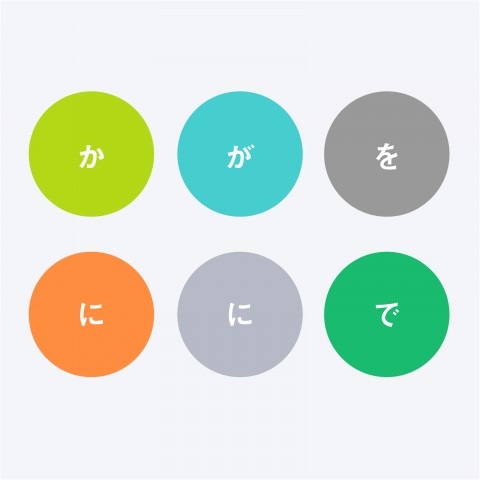
The postpositional particles are used in a Japanese sentence to modify words.
3. The Distinguishable Features of Word Order in Japanese Sentences
Compared to English, one of the distinguishable features of word order in Japanese is that Japanese has a 述語 (Jyutsugo), grammatically translated as “predicate.”
The predicate is one of the two main parts of a sentence stating something about the subject. While an English predicate can appear in the middle of a sentence, a Japanese 述語 (Jyutsugo) is always placed at the end of a sentence. This applies to both the casual form and the polite form.
Japanese: 私は本を読みます。(Watashi wa hon o yomimasu.) >> 読みます(yomimasu) is the predicate.
English: “I read the book.” >> “read the book” is the predicate.
2. The Basic Word Order of Japanese

1. SOV in Japanese
As we saw in the previous section, the basic sentence structure of Japanese is S (subject) – O (object) – V (verb).
Japanese parts of speech are usually followed by 助詞 (Joshi), or “particles,” that modify the word in front.
The subject is the person or thing that’s being discussed or described in a sentence, and the Japanese subject is usually followed by は (wa) or が (ga), which are 格助詞 (Kaku-Joshi) meaning “case markers” or 係助詞 (Kakari-Joshi) meaning “binding particles.”
The object is usually a noun or pronoun that is acted upon by the subject. A Japanese object is followed by a particle, such as を (o) or に (ni), which are 格助詞 (Kaku-Joshi).
The verb conveys an action (eat, write, move, etc.), an occurrence (happen, change), or a state of being (be, seem, exist). Japanese verbs either end the sentence, or are followed by 丁寧体 (Teinei-tai) such as です (desu) or ます (masu) in the polite form.
| Word Order | SVO : English (subject)-(verb)-(object) |
| Example | “I read the book.” |
| “I am a musician.” | |
| “The book is about music.” |
| SOV : Japanese (subject)-(object)-(verb) | Literal translation following the word order |
| 私は本を読みます。 Watashi wa hon o yomimasu. | I / the book / read. |
| 私は音楽家です。 Watashi wa ongakuka desu. | I / a musician / am. |
| その本は音楽についてです。 Sono hon wa ongaku ni tsuite desu. | The book / the music / about / is. |
2. Flexible Word Order
As we mentioned earlier, in Japanese grammar, word order is pretty flexible. Look at the diagram of the Japanese sentence structure in 1. 2. [2] above; the word order of the subject and object(s) is flexible. Even though the subject usually appears at the beginning of a sentence, the subject can also be placed in the middle or even be omitted.
Let’s take a look at the example.
S (subject) – O (object) – V (verb)
- (私は)明日図書館で友達と本を読みます。
(Watashi wa) ashita toshokan de tomodachi to hon o yomimasu.
(I) (tomorrow) (at the library) (with a friend) (the book) (read).
“I will read the book with a friend at the library tomorrow.”
The subject and object(s) can be placed in a variable order.
For example, the sentence above can also be in the following orders:
(私は)図書館で明日友達と本を読みます。
(Watashi wa) toshokan de ashita tomodachi to hon o yomimasu.
(私は)友達と図書館で明日本を読みます。
(Watashi wa) tomodachi to toshokan de ashita hon o yomimasu.
明日図書館で(私は)友達と本を読みます。
Ashita toshokan de (watashi wa) tomodachi to hon o yomimasu.
3. Word Order with Postpositional Phrases
While English uses prepositions (such as “at,” “on,” and “for”) to express a relationship to another word, Japanese uses postpositional particles, or 助詞 (Joshi). These particles come after the modified noun, verb, adjective, or at the end of a sentence.
There are several types of particles, categorized by function. However, we’ll only introduce the most essential particle: 格助詞 (Kaku-Joshi) or “case maker.”
When there are multiple objects, their order is flexible and variable as mentioned in the previous section.
| Meaning/Function | Reading | Hiragana | Example |
|---|---|---|---|
| Nominative case | -ga | ーが | 彼女が一番です。 Kanojo ga ichi-ban desu. “She is number one.” |
| Location | -de | ーで | ここで食べます。 Koko de tabemasu. “(I) eat here.” |
| Destination | -e | ーへ | 彼は図書館へいきます。 Kare wa toshokan e ikimasu. “He goes to the library.” |
| Dative case / Time | -ni | ーに | Dative: 彼は子供に本をあげました。 Kare wa kodomo ni hon o agemashita. “He gave the kid a book.” Time: 私は5時に出発します。 Watashi wa go-ji ni shuppatsu shimasu. “I depart at five o’clock.” |
| Origin | -kara | ーから | 駅は家から徒歩5分です。 Eki wa ie kara toho go-fun desu. “The station is a five-minute walk from home.” |
| Co-participant | -to | ーと | 彼女は彼と歌います。 Kanojo wa kare to utaimasu. “She sings with him.” |
| Objective case | -o | ーを | 私は本を読みます。 Watashi wa hon o yomimasu. “I read the book.” |
| Possessive case | -no | ーの | これは私のカバンです。 Kore wa watashi no kaban desu. “This is my bag.” |
| End point | -made | ーまで | 彼は駅まで歩きました。 Kare wa eki made arukimashita. “He walked to the station.” |
| Starting point / Comparative | -yori | ーより | Starting point: 会議は9時より行われます。 Kaigi wa ku-ji yori okonawaremasu. “The meeting will be held at nine o’clock.” Comparative: これはあれより安いです。 Kore wa are yori yasui desu. “This is cheaper than that.” |
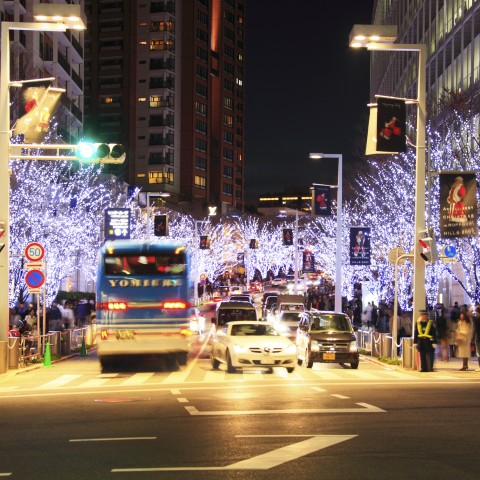
彼は駅まで歩きました。(Kare wa eki made arukimashita.), “He walked to the station.”
4. Word Order with Modifiers
With the basic Japanese word order rules in mind, let’s see how it works with modifiers to make more complex sentences.
A modifier is a word—such as an adjective, pronoun, or adverb—that expresses something about the word that follows it. Adjectives and pronouns modify nouns; adverbs modify verbs.
Here’s the Japanese word order with modifiers by function.
1. With Adjectives
In Japanese word order, adjectives come in front of nouns to describe them.
- 赤いりんご (akai ringo), “red apple”
- 分厚い本 (buatsui hon), “thick book”
In a sentence with a subject and verb, the format is: S (subject) – O (object) – V (verb).
- 彼は赤いりんごを食べました。(Kare wa akai ringo o tabemashita.), “He ate a red apple.”
- 私は分厚い本を読みます。(Watashi wa buatsui hon o yomimasu.), “I read the thick book.”
To learn more about Japanese adjectives, please visit our page on the Most Common Adjectives.
2. With Possessive Pronouns
Japanese possessive pronouns—such as 私の (watashi no) meaning “my” and 彼の (kare no) meaning “his”—come in front of nouns. The Japanese possessive case is の (-no) which is the postpositional particle marked after a person or thing.
- 私の車 (Watashi no kuruma), “my car”
- 彼女の家 (Kanojo no ie), “her house”
In a sentence with a subject and verb:
- 彼は私の車を使いました。(Kare wa watashi no kuruma o tsukaimashita.), “He used my car.”
- 私は彼女の家へ行きました。(Watashi wa kanojo no ie e ikimashita.), “I went to her house.”
3. With Adverbs
Adverbs modify verbs, adjectives, or other adverbs. Japanese adverbs come in front of the words they modify.
- 静かに話します (shizuka ni hanashimasu), “speak quietly”
- ひどく疲れました (hidoku tsukaremashita), “terribly tired”
In a sentence with a subject and verb:
- 彼女は静かに話します。(Kanojo wa shizuka ni hanashimasu.), “She speaks quietly.”
- 彼女はとても静かに話します。(Kanojo wa totemo shizuka ni hanashimasu.), “She speaks very quietly.”
- 私はひどく疲れました。(Watashi wa hidoku tsukaremashita.), “I got terribly tired.”
For more about Japanese adverbs, please check out our page on Must-Know Adverbs and Phrases for Connecting Thoughts.
4. With Numerals
When numerals modify a noun, they come before that noun. When numerals are used as an object, they come before verbs.
- 一冊の本 (Issatsu no hon), “one book”
- 二つのりんご (Futatsu no ringo), “two apples”
- 5匹います (Go-hiki imasu), “there are five (kinds of animals)”
In a sentence with a subject and verb:
- 私は1冊の本を読みます。(Watashi wa issatsu no hon o yomimasu.), “I read one book.”
- 木から落ちたのは二つのりんごです。(Ki kara ochita no wa futatsu no ringo desu.), “What fell from a tree are two apples.”
- 動物園にパンダが5頭います。(Dōbutsuen ni panda ga go-tō imasu.), “There are five pandas in the zoo.”
There’s a great variety of Japanese counter words which are used when talking about things, actions, or events.
For more about the basics of Japanese numbers, please visit Numbers and Kanji for Numbers and Counters.

Dōbutsuen ni panda ga go-tō imasu. (“There are five pandas in the zoo.”)
5. Asking Questions
Making an interrogative sentence in Japanese is surprisingly easy! It doesn’t involve changing the word order or adding an auxiliary verb to form a question, like in English (e.g. You swim. >> Do you swim?).
In Japanese, you only have to add か (ka), a question marker, to the end of a sentence and pronounce it with a rising intonation.
Polite / Basic Sentence
- 私は本を読みます。(Watashi wa hon o yomimasu.), “I read the book.”
Question: 私は本を読みますか。 (Watashi wa hon o yomimasu ka.), “Do I read the book?”
- これは100円です。(Kore wa hyaku-en desu.), “This is 100 yen.”
Question: これは100円ですか。 (Kore wa hyaku-en desu ka.), “Is this 100 yen?”
- 彼女は肉を食べません。(Kanojo wa niku o tabemasen.), “She doesn’t eat meat.”
Question: 彼女は肉を食べませんか。(Kanojo wa niku o tabemasen ka.), “Doesn’t she eat meat?”
Casual Sentence
In casual and colloquial speech, just change the pronunciation to have a rising intonation at the end of a sentence, without adding か (ka).
- 今日は寒い。(Kyō wa samui.), “Today is cold.”
Question: 今日は寒い? (Kyō wa samui?), “Is today cold?”
- 私に小包が届いた。(Watashi ni kozutsumi ga todoita.), “The parcel was delivered to me.”
Question: 私に小包が届いた? (Watashi ni kozutsumi ga todoita?), “Was the parcel delivered to me?”
- (あなたは)犬が好き。[(Anata wa) inu ga suki.], “You like dogs.”
Question:(あなたは)犬が好き? [(Anata wa) inu ga suki?], “Do you like dogs?”
6. Let’s Practice Making a Sentence in Japanese!
Learning by doing is the best way to master! Now, let’s practice making a Japanese sentence, step by step, with the Japanese word order rules you’ve learned today. If you don’t remember anything, feel free to review the sections above!
Try to translate the following sentences in Japanese.
1. “You went to the library.” : _________________
2. “You went to the library in the morning.” : _________________
3. “You went to the library in the morning at eight o’clock.” : _________________
4. “Did you go to the library in the morning?” : _________________
5. “She ate sushi today.” : _________________
6. “She ate sushi with Mariko today.” : _________________
7. “She ate sushi with Mariko for lunch today.” : _________________
8. “Did she eat sushi with Mariko for lunch today?” :_________________
If you don’t know certain vocabulary words, please check out our lists for the 50 Most Common Verbs and our School Vocabulary.

“Library” in Japanese is 図書館 (toshokan).
[Answers]
1. “You went to the library.”
あなたは図書館へ行きました。(Anata wa toshokan e ikimashita.)
2. “You went to the library in the morning.”
あなたは朝図書館へ行きました。(Anata wa asa toshokan e ikimashita.)
3. “You went to the library in the morning at eight o’clock.”
あなたは朝8時に図書館へ行きました。(Anata wa asa hachi-ji ni toshokan e ikimashita.)
4. “Did you go to the library in the morning?”
あなたは朝図書館へ行きましたか。(Anata wa asa toshokan e ikimashita ka.)
5. “She ate sushi today.”
彼女は今日寿司を食べました。(Kanojo wa kyō sushi o tabemashita.)
6. “She ate sushi with Mariko today.”
彼女は今日まりこと寿司を食べました。(Kanojo wa kyō Mariko to sushi o tabemashita.)
7. “She ate sushi with Mariko for lunch today.”
彼女は今日お昼ご飯にまりこと寿司を食べました。(Kanojo wa kyō o-hirugohan ni Mariko to sushi o tabemashita.)
8. “Did she eat sushi with Mariko for lunch today?” :
彼女は今日まりこと寿司を食べましたか。(Kanojo wa kyō Mariko to sushi o tabemashita ka.)
*The word order of objects can vary when there are many in a sentence.
7. Conclusion: How JapanesePod101 Can Help You Learn More Japanese
In this article, we introduced you to Japanese word order. Now you understand how the Japanese sentence structure works. At first, you might feel confused about the flexibility of Japanese word order, but you’ll find it’s actually a lot easier to make complex sentences once you get used to it!
If you would like to learn more about the Japanese language and practice other useful Japanese phrases for any situation, you’ll find a lot more helpful content on JapanesePod101.com. We provide a variety of free lessons to help you improve your Japanese language skills. Here’s some more information about the basics of Japanese with audio: Top 10 Sentence Patterns for Beginners and Most Useful Pronouns.
And there’s so much more we can offer you! Learn faster and enjoy studying Japanese at JapanesePod101.com!
Before you go, let us know in the comments if you still have questions about Japanese word order. We’d be glad to help.

How to Tell Time in Japanese

Telling time is one of the most essential aspects of everyday life. Learning how to tell time in Japanese will help you improve your basic Japanese language skills. Whether you’re checking the time for transportation or making an appointment, knowing how to say time in Japanese will help you when visiting Japan.
Telling time in Japanese is quite simple and easy to understand. Unlike in English, when expressing time in Japanese, the words which indicate the hour and minute are always added next to the numbers (e.g. 3:12 or three twelve = 時 (3ji) 分 (12fun). Thus, even without context or a sentence, you’ll easily understand that these phrases indicate time in Japanese.
In this article, we introduce the basic vocabulary and phrases for telling time in Japanese. Let’s get started!
 Table of Contents
Table of Contents
- How to Ask for the Time
- Telling Time in Japanese: Hours
- Telling Time in Japanese: Minutes
- The Hours Divided into Minutes
- General Time Reference of the Day
- Adverbs of Time in Japanese
- Time Proverbs and Sayings
- Conclusion: How JapanesePod101 Can Help You Learn More Japanese
1. How to Ask for the Time

Here’s a list of the most typical phrases for asking about time in Japanese.
1- What time is it now?
Japanese: 今何時ですか。
Reading: Ima nan-ji desu ka.
- すみません、今何時ですか。
Sumimasen, ima nan-ji desu ka.
Excuse me, what time is it now?
2- Do you know the time now?
Japanese: 今何時かわかりますか。
Reading: Ima nan-ji ka wakarimasu ka.
- ちょっといいですか、今何時かわかりますか。
Chotto ii desu ka, ima nan-ji ka wakarimasu ka.
Can I talk to you a bit? Do you know the time now?
3- What time is the [e.g. meeting]?
Japanese: [会議] は何時ですか。
Reading: [Kaigi] wa nan-ji desu ka.
- 田中さん、到着は何時ですか。
Tanaka-san, tōchaku wa nan-ji desu ka.
Mr. (Ms.) Tanaka, what time is the arrival?
4- What time do we meet up?
Japanese: 何時に集合ですか。
Reading: Nan-ji ni shūgō desu ka.
- すみません、7月10日は何時に集合ですか。
Sumimasen, shichi-gatsu tōka wa nan-ji ni shūgō desu ka.
Excuse me, what time do we meet up on July 10?
To learn dates in Japanese, please visit our Reading Dates in Japanese article.

Japanese people are famous for being on time.
2. Telling Time in Japanese: Hours
When speaking, the twelve-hour clock is more commonly used; when written, either the twelve-hour clock or the twenty-four-hour clock is used for telling time in Japanese.
When using the twelve-hour clock, add 午前 (gozen) meaning “a.m.” or 午後 (gogo) meaning “p.m.” to clarify.
1- The Twelve-Hour Clock in Japanese
Add 時 (ji), meaning “hour” or “o’clock,” after the Japanese numbers. Keep in mind that Arabic numbers are commonly used.
| English | Kanji | Hiragana | Reading |
|---|---|---|---|
| 0 o’clock | 零時 | れいじ | rei-ji |
| 1 o’clock | 一時 | いちじ | ichi-ji |
| 2 o’clock | 二時 | にじ | ni-ji |
| 3 o’clock | 三時 | さんじ | san-ji |
| 4 o’clock | 四時 | よじ | yo-ji |
| 5 o’clock | 五時 | ごじ | go-ji |
| 6 o’clock | 六時 | ろくじ | roku-ji |
| 7 o’clock | 七時 | しちじ | shichi-ji |
| 8 o’clock | 八時 | はちじ | hachi-ji |
| 9 o’clock | 九時 | くじ | ku-ji |
| 10 o’clock | 十時 | じゅうじ | jū-ji |
| 11 o’clock | 十一時 | じゅういちじ | jū ichi-ji |
| 12 o’clock | 十二時 | じゅうにじ | jū ni-ji |
Please visit our Japanese Numbers article and Numbers page on JapanesePod101 to learn how to read numbers in Japanese.
2- Examples
- 昼食の時間は午後1時です。
Chūshoku no jikan wa gogo ichi-ji desu.
Lunch time is at one o’clock p.m.
- 会議は10時からですか。
Kaigi wa jū-ji kara desu ka.
Is the meeting at ten o’clock?
- 明日の朝7時に来てください。
Ashita no asa shichi-ji ni kite kudasai.
Please come at seven o’clock tomorrow morning.
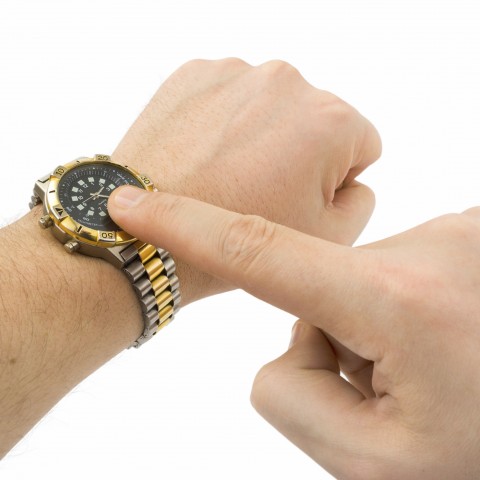
Toki wa kane nari (Time is money).
3. Telling Time in Japanese: Minutes
1- Minutes in Japanese
Unlike in English, 分 (fun) or (pun) meaning “minute” is always added after the numbers when telling minutes in Japanese.
- “Minute(s)” in Japanese is 分 and it’s pronounced either fun or pun depending on which number comes before 分.
- Minutes are usually written with Arabic numbers rather than Kanji.
| English | Kanji | Hiragana | Reading |
|---|---|---|---|
| 1 minute | 一分 | いっぷん | ippun |
| 2 minutes | 二分 | にふん | ni-fun |
| 3 minutes | 三分 | さんぷん | san-pun |
| 4 minutes | 四分 | よんふん | yon-fun |
| 5 minutes | 五分 | ごふん | go-fun |
| 6 minutes | 六分 | ろっぷん | roppun |
| 7 minutes | 七分 | ななふん | nana-fun |
| 8 minutes | 八分 | はっぷん | happun |
| 9 minutes | 九分 | きゅうふん | kyū-fun |
| 10 minutes | 十分 | じゅっぷん | juppun |
| 20 minutes | 二十分 | にじゅっぷん | ni-juppun |
| 30 minutes | 三十分 | さんじゅっぷん | san-juppun |
| 40 minutes | 四十分 | よんじゅっぷん | yon-juppun |
| 50 minutes | 五十分 | ごじゅっぷん | go-juppun |
2- Examples
- 地震は朝9時24分に起きました。
Jishin wa asa ku-ji ni-jū yon-fun ni okimashita.
The earthquake occurred at 9:24 in the morning.
- 次の電車は3時47分に来ます。
Tsugi no densha wa san-ji yon-jū nana-fun ni kimasu.
The next train comes at 3:47.
- 今の時間は午後6時18分です。
Ima no jikan wa gogo roku-ji jū happun desu.
The current time is 6:18 p.m.

It is jū-ji jū ippun (10:11) in Japanese.
4. The Hours Divided into Minutes
Telling time with minutes in Japanese is quite simple and there are no special terms or phrases to express certain groups of minutes, except for 半 (han) meaning “half.” On the other hand, English has more specific expressions, such as “quarter,” “XX past two (XX minutes after two o’clock),” and “XX to seven (XX minutes before seven o’clock).”
- To express “thirty minutes past XX o’clock” in Japanese, just add 半 (han), meaning “half,” after “number + 時 (ji).”
- There’s no particular word for “quarter” when telling time in Japanese. It‘s simply “fifteen minutes”: 15分 (jū go-fun).
- “Five past six,” or 6:05, is 6時5分 (roku-ji go-fun) in Japanese.
- “Ten to seven” is 7時10分前 (shichi-ji juppun mae) in Japanese, which literally means “Ten minutes before seven o’clock.”
Examples
- 飛行機は朝8時半に出発します。
Hikōki wa asa hachi-ji han ni shuppatsu shimasu.
The airplane departs at 8:30 in the morning.
- 明日の会議は3時15分前に来てください。
Ashita no kaigi wa san-ji jū go-fun mae ni kite kudasai.
Please come to tomorrow’s meeting fifteen minutes before three o’clock.
- 今の時間は9時10分前です。
Ima no jikan wa ku-ji juppun mae desu.
The current time is ten minutes before nine o’clock.
- あの学校は朝6時半に開きます。
Ano gakkō wa asa roku-ji han ni akimasu.
That school opens at 6:30 in the morning.
5. General Time Reference of the Day
What if you want to give a nonspecific or approximate time in Japanese? Here’s some basic vocabulary for describing time in Japanese based on the general time of day.
| English | Kanji | Hiragana | Reading |
|---|---|---|---|
| AM | 午前 | ごぜん | gozen |
| PM | 午後 | ごご | gogo |
| morning | 朝 | あさ | asa |
| early morning | 早朝 | そうちょう | sōchō |
| sunrise | 日の出 | ひので | hinode |
| noon | 正午 | しょうご | shōgo |
| midday | 日中 | にっちゅう | nicchū |
| early evening | 夕方 | ゆうがた | yūgata |
| sunset | 日没 | にちぼつ | nichibotsu |
| evening / night | 夜 | よる | yoru |
| midnight | 深夜 | しんや | shin’ya |

The sunset time in summer is around seven o’clock p.m. in Japan.
Examples
- 夏の日の出は早朝の4時半です。
Natsu no hinode wa sōchō no yo-ji han desu.
The sunrise in summer is at 4:30 in the early morning.
- 明日の夜8時に夕食を食べましょう。
Ashita no yoru hachi-ji ni yūshoku o tabemashō.
Let’s have dinner at eight o’clock tomorrow evening.
- 私の飛行機は深夜12時3分に出発します。
Watashi no hikōki wa shin’ya jū ni-ji san-pun ni shuppatsu shimasu.
My flight departs at 12:03, at midnight.
- 私は今日正午から夕方まで忙しいです。
Watashi wa kyō shōgo kara yūgata made isogashii desu.
I’m busy from noon to early evening today.
6. Adverbs of Time in Japanese

You can create more-detailed and specific time-related expression by using time adverbs. Japanese adverbs of time include:
| English | Kanji | Hiragana | Reading |
|---|---|---|---|
| right now | 今すぐ | いますぐ | ima sugu |
| before | 前 | まえ | mae |
| after | 後 | あと/ご | ato/go |
| soon | ー | もうすぐ | mō sugu |
| soon | ー | ほとんど | hotondo |
| around | 頃 | ころ/ごろ | koro/goro |
| about | 約 | やく | yaku |
| currently | 現在 | げんざい | genzai |
| meanwhile | その間に | そのあいだに | sono aida ni |
| at the same time | 同時に | どうじに | dōji ni |
| at the same time | ー | いつでも | itsu demo |
| as soon as possible | 出来るだけ早く | できるだけはやく | dekirudake hayaku |
| in a while | 間もなく/しばらく | まもなく/しばらく | mamonaku/shibaraku |
| for a long time | 長い間 | ながいあいだ | nagai aida |
Examples
- 今すぐ来きてください。会議は15分後に始まります。
Ima sugu kite kudasai. Kaigi wa jū go-fun go ni hajimarimasu.
Please come right now. The meeting is starting after fifteen minutes.
- 同時に、別のパーティーが午後7時半から始まります。
Dōji ni, betsu no pātī ga gogo shichi-ji han kara hajimarimasu.
At the same time, another party will start at 7:30 p.m.
- 私は午前8時から長い間待っています。出来るだけ早くここへ来てください。
Watashi wa gozen hachi-ji kara nagai aida matte imasu. Dekirudake hayaku koko e kite kudasai.
I have been waiting for a long time, since 8 o’clock a.m. Come here as soon as possible.
- 今は午後2時58分で、もうすぐ3時になります。まもなく電車が来ます。
Ima wa gogo ni-ji go-jū happun de, mō sugu san-ji ni narimasu. Mamonaku densha ga kimasu.
It is 2:58 p.m. and it’s going to be 3:00 soon. The train comes in a while.

Japanese trains are very punctual.
7. Time Proverbs and Sayings
When talking about time in Japanese culture, there are many ことわざ (kotowaza) and 慣用句 (kan’yōku), or “proverbs” and “sayings” regarding time in Japanese. Here are some of the most famous proverbs.
- Time is money.
Japanese: 時は金なり
Reading: Toki wa kane nari
Meaning: It literally translates to “time is money,” and it means that time is as precious as money.
遅れないように! 「時は金なり」ですよ。
Okurenai yō ni! “Toki wa kane nari” desu yo.
Don’t be late! Time is money.
- Time flies.
Japanese: 光陰矢のごとし
Reading: Kōin ya no gotoshi
Meaning: It literally translates to “time is like an arrow,” meaning that time flies fast, like an arrow. The word 光陰 (Kōin) comes from 漢文 (Kanbun), an old Chinese word which denotes “light and shade,” meaning “time.” Thus, time goes by with days and nights.
前回会った時から既に5年経ちました。「光陰矢のごとし」ですね。
Zenkai atta toki kara sude ni go-nen tachimashita. “Kōin ya no gotoshi” desu ne.
Five years have already passed since we last met. Time flies, doesn’t it?
- Time and tide wait for no man.
Japanese: 歳月人を待たず
Reading: Saigetsu hito o matazu
Meaning: It literally translates to “years and months do not wait for man,” meaning that time goes by constantly without heeding one’s circumstances. It indicates that people shouldn’t waste time and should instead make each day count.
やるべき事ややりたい事は今すぐやりましょう。「歳月人を待たず」ですよ!
Yarubeki koto ya yaritai koto wa ima sugu yarimashō. ”Saigetsu hito o matazu” desu yo!
Do right now what you should do and what you want to do. It’s “time and tide wait for no man!”
- Each day is like a thousand years.
Japanese: 一日千秋
Reading: Ichijitsu senshū
Meaning: It literally translates to “one day is like a thousand autumns.” It means that one can hardly wait for something because it feels very far in the future, as if one day is like a thousand years (autumn comes a thousand times). 秋 (aki/shū) means “autumn,” but it also can mean “time” as a metaphor. It’s said that autumn is the time for harvest, and ancient people realized that a year had passed when autumn came.
彼女は来月行く予定のコンサートを一日千秋の思いで待っています。
Kanojo wa raigetsu iku yotei no konsāto o ichijitsu senshū no omoi de matte imasu.
She’s waiting for the concert she’s going to next month with the feeling that each day is like a thousand years.
8. Conclusion: How JapanesePod101 Can Help You Learn More Japanese

In this article, we introduced how to tell time in Japanese, including the basic vocabulary and phrases, such as the different units of time in Japanese. Now you can ask for the time and tell time in Japanese whenever you make an appointment or check times for your travels.
I hope you’ll enjoy meeting friends and getting around in Japan; make sure you’re on time when meeting them!
Are there any time-related words in Japanese you still want to know? Let us know in the comments!
If you would like to learn more about the Japanese language and other useful Japanese phrases, you’ll find a lot of helpful content on JapanesePod101.com. We provide a variety of free lessons for you to improve your Japanese language skills. Here’s some more information about numbers and time in Japanese with audio: Talking about Time, Numbers, and Kanji for Numbers and Counters.
To learn how to make conversation in Japanese, check out Top 15 Questions You Should Know for Conversations and Top 10 Conversational Phrases. Phrases You Need at the Bus or Train Station and Trains are also useful if you plan on getting around Japan with public transportation.
There’s so much more! Be a fast learner and enjoy studying Japanese at JapanesePod101.com!

Giving and Asking for Directions: “Right” in Japanese & More

Knowing how to ask for directions in Japanese is very helpful when it comes to getting around in Japan. In particular, finding the right address can be a bit confusing, because smaller streets in Japan aren’t named and addresses are expressed with the name of a small area and numbers.
Along with knowing how to ask directions in Japanese, understanding the directions you were told is even more important. This ensures that you can reach the destination with the information given. (You don’t want to mistake “right” in Japanese for left!)
But don’t worry! Japanese people are kind in general, and they’ll stop to listen and help you when you ask them for directions in Japanese.
Here’s some useful vocabulary and phrases for giving and asking for directions in Japanese. Master directions in Japanese at JapanesePod101.com and find your way to exciting destinations!

Table of Contents
- On the Map: Cardinal Directions in Japanese
- On the Road
- Giving Directions in Japanese Using Landmarks
- Must-Know Phrases for Asking for Directions in Japanese
- Must-Know Phrases for Giving Directions in Japanese
- Other Useful Phrases for Asking Directions with Map/Phone
- Conclusion: How JapanesePod101 Can Help You Learn More Japanese
1. On the Map: Cardinal Directions in Japanese

Let’s master the basic compass directions in Japanese for reading the map.
1- Basic Vocabulary
| Reading | Kanji | Hiragana | English |
| kita | 北 | きた | north |
| minami | 南 | みなみ | south |
| nishi | 西 | にし | west |
| higashi | 東 | ひがし | east |
| hokusei | 北西 | ほくせい | northwest |
| hokutō | 北東 | ほくとう | northeast |
| nantō | 南東 | なんとう | southeast |
| nansei | 南西 | なんせい | southwest |
| chizu | 地図 | ちず | map |
| genzaichi | 現在地 | げんざいち | current location |
2- Examples
- 皇居は現在地から北東へ5kmの場所にあります。
Kōkyo wa genzaichi kara hokutō e go-kiromētoru no basho ni arimasu.
The Imperial Palace is located 5km northeast from the current location. - 日本の地理は、北の北海道、東の関東、西の関西、南の九州が特徴です。
Nihon no chiri wa, kita no Hokkaidō, higashi no Kantō, nishi no Kansai, minami no Kyūshū ga tokuchō desu.
The geography of Japan is characterized by Hokkaidō of the North, Kantō of the East, Kansai of the West, and Kyūshū of the south. - 横浜は、東京の南に位置しています。
Yokohama wa Tōkyō no minami ni ichi shite imasu.
Yokohama is located in the south of Tokyo.
 The Japanese map shows the major roads with names, but small streets don’t have names. It’s useful to know the word kita, meaning “north” in Japanese, for reading the map.
The Japanese map shows the major roads with names, but small streets don’t have names. It’s useful to know the word kita, meaning “north” in Japanese, for reading the map.
2. On the Road
Knowing how to say directions in Japanese for the road, such as right and left in Japanese, is very useful. The vocabulary below is essential for giving and receiving driving directions in Japanese!1- Basic Vocabulary
| Reading | Kanji | Hiragana | English |
| mae | 前 | まえ | front |
| ushiro | 後ろ | うしろ | back |
| hidari | 左 | ひだり | left |
| migi | 右 | みぎ | right |
| tōi | 遠い | とおい | far |
| chikai | 近い | ちかい | close |
| koko | ー | ここ | here |
| asoko | ー | あそこ | there |
| massugu | ー | まっすぐ | straight |
| tonari | 隣 | となり | next |
| watatta | 渡った | わたった | across |
| kōsaten | 交差点 | こうさてん | intersection |
| kado o magaru | 角を曲がる | かどをまがる | turn the corner |
2- Examples
- 東京タワーは東京プリンスホテルの隣にあります。次の角を右に曲がって、まっすぐ進んでください。
Tōkyō Tawā wa Tōkyō Prince Hotel no tonari ni arimasu. Tsugi no kado o migi ni magatte, massugu susunde kudasai.
Tokyo Tower is located next to Tokyo Prince Hotel. Please turn right at the next corner and go straight. - 明治神宮は原宿駅から200mくらいの場所で、近いです。
Meiji Jingū wa Harajuku Eki kara ni-hyaku-mētoru kurai no basho de, chikai desu.
Meiji Jingū is located around 200m away from Harajuku Station and it is close. - 都庁のビルは、新宿中央公園から交差点を渡った場所にあります。
Tochō no biru wa, Shinjuku Chūō Kōen kara kōsaten o watatta basho ni arimasu.
The Tokyo Metropolitan Government Building is located across the intersection from Shinjuku Central Park. - あそこの交差点を左に曲がって道をまっすぐ行くと、前に駅が見えます。
Asoko no kōsaten o hidari ni magatte michi o massugu iku to, mae ni eki ga miemasu.
When you turn left at the intersection there, go straight on the street; you will see the station in front.

When you’re at an intersection or on a road, migi, meaning “right” in Japanese, and hidari, meaning “left” in Japanese, are essential words to use for giving/asking directions.
3. Giving Directions in Japanese Using Landmarks
A landmark is an object or feature of a landscape or city that’s easily seen and recognized from a distance. Know the basic vocabulary for landmarks will help you understand when you’re getting directions in Japanese.
1- In the City: Basic Vocabulary
| Reading | Kanji | Hiragana / Katakana | English |
| kūkō | 空港 | くうこう | airport |
| chikatetsu no ek | 地下鉄の駅 | ちかてつのえき | subway station |
| machi no chūshinchi | 街の中心地 | まちのちゅうしんち | center of the city |
| kōen | 公園 | こうえん | park |
| hoteru | ー | ホテル | hotel |
| byōin | 病院 | びょういん | hospital |
| ginkō | 銀行 | ぎんこう | bank |
Examples
- 地下鉄の駅は、この道をまっすぐ進むと、銀行の隣にあります。
Chikatetsu no eki wa, kono michi o massugu susumu to, ginkō no tonari ni arimasu.
The subway station is located next to the bank when you go straight on this road. - この街の中心地は駅の近くで、あそこの病院を右に曲がって500mくらいの場所にあります。
Kono machi no chūshinchi wa eki no chikaku de, asoko no byōin o migi ni magatte go-hyaku-mētoru kurai no basho ni arimasu.
The center of this city is located near the station, and it’s 500m away after you turn right at the hospital there. - この交差点を左に曲がると、地下鉄の駅があります。
Kono kōsaten o hidari ni magaru to, chikatetsu no eki ga arimasu.
When you turn left at this intersection, the subway station is there.
2- On the Road: Basic Vocabulary
| Reading | Kanji | Hiragana / Katakana | English |
| shingō | 信号 | しんごう | traffic light |
| ōdanhodō | 横断歩道 | おうだんほどう | crosswalk |
| kado | 角 | かど | corner |
| tatemono / biru | 建物 / ビル | たてもの / ビル | building |
| kōban / keisatsusho | 交番 / 警察署 | こうばん / けいさつしょ | police station |
| eki | 駅 | えき | train station |
| basutei | バス停 | バスてい | bus stop |
| hashi | 橋 | はし | bridge |
A 交番 こうばん (kōban) is a small police station in a community, and is the smallest unit of the police structure in Japan. On the other hand, a 警察署 けいさつしょ (keisatsusho) is a large police station which is usually the headquarters of the police station in a city or area.
Examples
- 駅は、あの横断歩道を渡って右にある高い建物の後ろにあります。
Eki wa, ano ōdanhodō o watatte migi ni aru takai tatemono no ushiro ni arimasu.
The train station is located at the back of the tall building on the right after crossing that crosswalk. - この道をまっすぐ進むと、左に交番が見えます。交番の角を右に曲がるとバス停があります。
Kono michi o massugu susumu to, hidari ni kōban ga miemasu. Kōban no kado o migi ni magaru to basutei ga arimasu.
When you go straight on this street, you will see the police station on your left. There is the bus stop after you turn right at the corner of the police station. - あの橋を渡って見える大きい建物は横浜ホテルです。
Ano hashi o watatte mieru ōkii tatemono wa Yokohama Hotel desu.
The big building you see across that bridge is Yokohama Hotel.
 Tokyo Tower is one of the most famous landmarks in Tokyo.
Tokyo Tower is one of the most famous landmarks in Tokyo.
3- In a Structure/Building: Basic Vocabulary
| Reading | Kanji | Hiragana / Katakana | English |
| iriguchi | 入口 | いりぐち | entrance |
| deguchi | 出口 | でぐち | exit |
| keshōshitsu / toire | 化粧室 / トイレ | けしょうしつ / トイレ | restroom |
| kaidan | 階段 | 階段 | stairs |
| erebētā | ー | エレベーター | elevator |
| mon | 門 | もん | gate |
| chūshajō | 駐車場 | ちゅうしゃじょう | parking lot |
Examples
- 地下鉄の駅の入口は、この階段を降りた右側にあります。
Chikatetsu no eki no iriguchi wa, kono kaidan o orita migigawa ni arimasu.
The entrance of the subway station is located at the right side after going down the stairs. - トイレはこのビルの3階にあります。あのエレベーターで3階に行けます。
Toire wa kono biru no san-kai ni arimasu. Ano erebētā de san-kai ni ikemasu.
There is a toilet on the third floor in this building. You can go to the third floor with that elevator. - あの駐車場の門の隣に出口があります。
Anochūshajō no mon no tonari ni deguchi ga arimasu.
There is an exit next to that gate in the parking lot.
 There are many exit gates in the large stations in Japan’s larger cities.
There are many exit gates in the large stations in Japan’s larger cities.
4. Must-Know Phrases for Asking for Directions in Japanese

Here’s a list of useful phrases and examples for how to ask for directions in Japanese.
1- Polite Phrases to Begin Your Question
すみません (sumimasen) — Excuse me
すみません、この駅の入口はどこですか。Sumimasen, kono eki no iriguchi wa doko desu ka.
Excuse me, where is the entrance to this station?
ちょっといいですか。(Chotto ii desu ka.) — Can I talk to you? / May I ask a bit?
ちょっといいですか。渋谷駅はどこですか。Chotto ii desu ka. Shibuya Eki wa doko desu ka.
Can I talk to you a bit? Where is Shibuya station?
助けてもらえますか。(Tasukete moraemasu ka.) — Will you help me?
助けてもらえますか。空港までの行き方を教えてくれませんか。Tasukete moraemasu ka. Kūkō made no ikikata o oshiete kuremasen ka.
Will you help me? Can you show me the way to go to the airport?
2- Example Phrases Using “Where is…?”
…はどこですか。(… wa doko desu ka.) — Where is …?
- すみません、トイレはどこですか。
Sumimasen, toire wa doko desu ka.
Excuse me, where is the toilet? - ちょっといいですか。代々木公園はどこですか。
Chotto ii desu ka. Yoyogi Kōen wa doko desu ka.
Can I talk to you? Where is Yoyogi Park? - すみません、お台場はどこですか。
Sumimasen, Odaiba wa doko desu ka.
Excuse me, where is Odaiba?
3- Example Phrases Using “How do I get to…?”
…にはどうやって行けばいいですか。 (… ni wa dō yatte ikeba ii desu ka.) — How do I get to…?
- 浅草にはどうやって行けばいいですか。
Asakusa ni wa dō yatte ikeba ii desu ka.
How do I get to Asakusa? - 皇居方面の出口にはどうやって行けばいいですか。
Kōkyo hōmen no deguchi ni wa dō yatte ikeba ii desu ka.
How do I get to the exit toward the Imperial Palace?
4- Example Phrases Using “How far is …?” / “Is … far from here?”
…はどの位遠いですか。 (…wa dono kurai tōi desu ka.) — How far is …?
…はここから遠いですか。(…wa koko kara tōi desu ka.) — Is … far from here?
- 東京タワーはどの位遠いですか。
Tōkyō Tawā wa dono kurai tōi desu ka.
How far is Tokyo Tower? - 駅はここから遠いですか。
Eki wa koko kara tōi desu ka.
Is the train station far from here?
5- Example Courtesy Phrases to Thank People
ありがとうございます (arigatō gozaimasu) — Thank you.
- ありがとうございます、とても助かりました。
Arigatō gozaimasu, totemo tasukarimashita.
Thank you, it helped me a lot.
分かりました、ありがとうございます。(wakarimashita, arigatō gozaimasu.) — I see, thank you.
- 駅への行き方分かりました、ありがとうございます。
Eki e no ikikata wakarimashita, arigatō gozaimasu.
I see how to get to the station, thank you.
親切にありがとうございました (shinsetsu ni arigatō gozaimashita.) — Thank you for your kindness.
- 建物の入り口まで連れて来てくれて、親切にありがとうございました。
Tatemono no iriguchi made tsurete kite kurete, shinsetsu ni arigatō gozaimashita.
Thank you for your kindness by taking me to the entrance of the building.
For more about saying thank you in Japanese, check out Common Ways to Say Thank You.
To learn greetings in Japanese, visit Japanese Greetings.
 Japanese people are very kind in general to show you the way to your destination.
Japanese people are very kind in general to show you the way to your destination.
5. Must-Know Phrases for Giving Directions in Japanese
Here’s a list of useful phrases and examples for giving directions in Japanese. You’ll also find taxi directions in Japanese that you can use as needed.1- go straight
Japanese: まっすぐ進みますReading: massugu susumi masu
- 地下鉄の駅へはこの道をまっすぐ進みます。
Chikatetsu no eki e wa kono michi o massugu susumimasu.
Go straight on this road to the subway station.
2- go back
Japanese: 戻りますReading: modorimasu
- 新宿駅へはこの道を、あの信号まで戻ります。
Shinjuku Eki e wa kono michi o, ano shingō made modorimasu.
Go back on this road until that traffic light to Shinjuku Station.
3- turn left/right
Japanese: 左 / 右へ曲がりますReading: hidari / migi e magarimasu
- あの信号を左へ曲がります。
Ano shingō o hidari e magarimasu.
Turn left at that traffic light.
4- turn left / right at corner / intersection
Japanese: 角 / 交差点を左 / 右へ曲がりますReading: kado / kōsaten o hidari / migi e magarimasu
- あの高いビルがある交差点を右へ曲がります。
Ano takai biru ga aru kōsaten o migi e magarimasu.
Turn right at the intersection where that tall building is.
5- on … floor
Japanese: …階Reading: …kai
- トイレは5階にあります。
Toire wa go-kai ni arimasu.
The toilet is on the fifth floor.
6- go upstairs / downstairs
Japanese: 階段を上がります / 下がりますReading: kaidan o agarimasu / sagarimasu
- トイレへはこの階段を上がります。
Toire e wa kono kaidan o agarimasu.
Go upstairs to the toilet.
7- (to a driver) keep going
Japanese: このまま行ってくださいReading: kono mama itte kudasai
- この道をこのまま行ってください。
Kono michi o kono mama itte kudasai.
Keep going on this road.
8- (to a driver) stop here
Japanese: ここで止まってくださいReading: koko de tomatte kudasai
- ホテルはここです。ここで止まってください。
Hoteru wa koko desu. Koko de tomatte kudasai.
The hotel is here. Please stop here.
9- (to a driver) hurry up
Japanese: 急いでくださいReading: isoide kudasai
- 時間があまりないので急いでください。
Jikan ga amari nai node isoide kudasai.
Please hurry up because there’s not much time.
10- (to a driver) slow down
Japanese: 速度を落としてくださいReading: sokudo o otoshite kudasai
- 急いでないので速度を落としてください。
Isoide nai node sokudo o otoshite kudasai.
Please slow down because I’m not in a hurry.
11- (to a driver) short-cut
Japanese: 近道Reading: chikamichi
- 駅への近道を知っていますか。
Eki e no chikamichi o shitte imasu ka.
Do you know the short-cut to the station?
12- You won’t miss it (you will see it immediately)
Japanese: すぐに分かりますReading: sugu ni wakarimasu
- 駅はあの銀行の裏です。すぐに分かりますよ。
Eki wa ano ginkō no ura desu. Sugu ni wakarimasu yo.
The station is behind that bank. You won’t miss it.
13- You will see xxx on the right / left side
Japanese: XXXは右 / 左に見えますReading: XXX wa migi / hidari ni miemasu
- この道をまっすぐ行くと、駅が左に見えます。
Kono michi o massugu iku to, eki ga hidari ni miemasu.
When you go straight on this road, you will see the station on the left side.
 The door of a Japanese taxi opens automatically for you.
The door of a Japanese taxi opens automatically for you.
6. Other Useful Phrases for Asking Directions with Map/Phone

Even if you’re using your phone to search for directions, it’s often confusing and difficult to figure it out in a foreign country. Here’s a list of useful phrases for asking directions in Japanese using a map or phone.
1- Can you indicate … on this map?
Japanese: …をこの地図で示してください。Reading: …o kono chizu de shimeshite kudasai
- 西新宿2丁目の2をこの地図で示してください。
Nishi-Shinjuku ni-chō-me no ni o kono chizu de shimeshite kudasai.
Can you indicate 2-2 Nishi-Shinjuku, please?
2- Please type the name of XXX on my phone / Google Maps
Japanese: 私の電話 / グーグルマップにXXXの名前を打ってください。Reading: watashi no denwa / Gūguru Mappu ni XXX no namae o utte kudasai.
- グーグルマップに両国国技館の名前を打ってください。
Gūguru Mappu ni Ryōgoku Kokugikan (Kokugikan 国技館) no namae o utte kudasai.
Please type the name of the Ryōgoku Sumo Hall on Google Maps.
3- Can you find XXX on Google Maps, please?
Japanese: XXXをグーグルマップで探してくれませんか。Reading: XXX o Gūguru Mappu de sagashite kuremasen ka.
- この住所をグーグルマップで探してくれませんか。
Kono jūsho o Gūguru Mappu de sagashite kuremasen ka.
Can you find this address on Google Maps, please?
 It’s useful to use a smartphone to search for locations, but it’s sometimes difficult to search for things in foreign languages.
It’s useful to use a smartphone to search for locations, but it’s sometimes difficult to search for things in foreign languages.
7. Conclusion: How JapanesePod101 Can Help You Learn More Japanese
In this article, we introduced the vocabulary and phrases for giving and asking directions in Japanese, including the basic cardinal directions for reading the map. When you ask Chikatetsu no eki wa doko desu ka. (“Where is the subway station?”), you should now be able to understand someone’s reply while giving directions in Japanese: Chikatetsu no eki e wa kono michi o massugu susumimasu. (“Go straight on this road to the subway station”).
I hope you enjoy getting around in Japan smoothly after learning directions in Japanese here!
Are there any phrases or direction vocabulary in Japanese you still want to know? Leave your comments and let us know; we look forward to hearing from you!
If you would like to learn more about the Japanese language and other useful Japanese phrases for various situations, you’ll find a lot more helpful content on JapanesePod101.com. We provide a variety of free lessons for you to improve your Japanese language skills. For example, here’s some more information about directions in Japanese with audio: Direction Words, Kanji for Direction and Position, and Position / Direction.
To learn how to make conversations in Japanese, check out Top 15 Questions You Should Know for Conversations and Top 10 Conversational Phrases. Survival Words & Phrases for Your Next Trip to Japan, Traveling, and Top 30 Travel Phrases You Should Know are also useful if plan on traveling to Japan.
There’s still so much more! Learn faster and enjoy studying Japanese at JapanesePod101.com!

Guide to the Top 100+ Japanese Nouns

Expanding one’s vocabulary is one of the most essential elements in improving one’s language skills. Learning Japanese nouns will help you boost your knowledge of the Japanese language because nouns occupy the majority of the language’s words. Knowing the top 100 Japanese nouns is the first step to enhance your Japanese vocabulary.
Japanese nouns are used to name a person, place, thing, or idea. Contrary to English, Japanese nouns don’t accompany any articles, such as “a” and “the.” In addition, there are no certain rules for indicating, in a precise sense, whether a noun is singular or plural. For example, there’s the word 達(たち) [tachi], which indicates a plural form of people or creatures when it’s put next to a noun (e.g. 動物 + 達 = 動物達:animals).
In most cases, however, Japanese nouns don’t have anything added to indicate the difference between singular and plural. In order to show that a certain noun in Japanese is plural, add another word such as たくさんの (takusan no), or “many,” and 二つの (futatsu no), or “two” in the sentence.
In this article, we introduce the 100 most common Japanese nouns. Let’s master the basic Japanese nouns in everyday life here at JapanesePod101! Here are the top Japanese nouns by category.

Table of Contents
- Japanese Nouns: Appliances
- Japanese Nouns: Technology
- Japanese Nouns: Transportation
- Japanese Nouns: Food & Restaurants
- Japanese Nouns: School Essentials
- Japanese Nouns: Occupations
- Japanese Nouns: Family Members
- Japanese Nouns: Body Parts
- Japanese Nouns: Time
- 10. Conclusion: How JapanesePod101 Can Help You Learn More Japanese
1. Japanese Nouns: Appliances

Before studying this basic Japanese nouns list, keep in mind that some of the imported words from other languages become Japanese words, or 和製英語 (wasei eigo), with a similar sound written in Katakana. For example, “television” is テレビ (terebi) in Japanese.
| English | Kanji | Hiragana/Katakana | Reading | |
| 1 | refrigerator | 冷蔵庫 | れいぞうこ | reizōko |
| 2 | freezer | 冷凍庫 | れいとうこ | reitōko |
| 3 | microwave | 電子レンジ | でんしれんじ | denshi renji |
| 4 | air conditioner | 冷房機/クーラー | れいぼうき/クーラー | reibōki / kūrā |
| 5 | heater | 暖房機 | だんぼうき | danbōki |
| 6 | laundry machine | 洗濯機 | せんたくき | sentakuki |
| 7 | hair dryer | ー | ドライヤー | doraiyā |
| 8 | TV | ー | テレビ | terebi |
Examples
冷凍庫から氷と、冷蔵庫から飲み物を出してください。Reitōko kara kōri to, reizōko kara nomimono o dashite kudasai.
Please take out ice from the freezer and drinks from the refrigerator.
お風呂の後はドライヤーで髪を乾かします。
O-furo no ato wa doraiyā de kami o kawakashimasu.
After taking a bath, I dry my hair with a hair dryer.
私はテレビを見ることが好きです。
Watashi wa terebi o miru koto ga suki desu.
I like watching TV.
電子レンジと洗濯機が壊れたので困っています。
Denshi renji to sentakuki ga kowareta node komatte imasu.
I’m upset because the microwave and laundry machine broke.
You can also check our more useful Japanese nouns for home appliances with Japanese pronunciations at our Home Appliances vocabulary list!
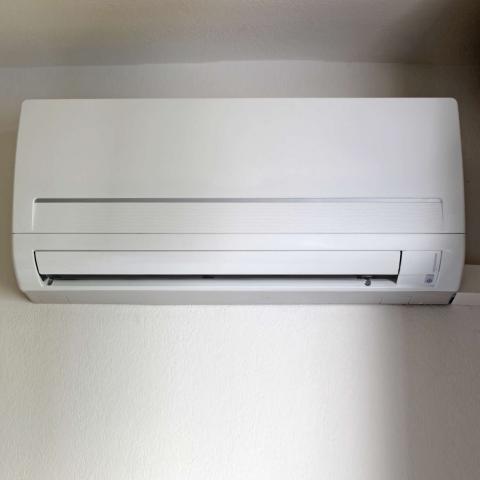
Air conditioner in Japanese is also called クーラー (kūrā), which comes from the word “cooler.”
2. Japanese Nouns: Technology
Most important Japanese nouns regarding technology originated from other countries and were imported to Japan. Expressed in Katakana, these imported words have Japanese pronunciation that resembles the original English words.
| English | Kanji | Hiragana/Katakana | Reading | |
| 9 | computer | ー | コンピューター | conpyūtā |
| 10 | laptop | ー | ノートパソコン | nōto pasokon |
| 11 | tablet | ー | タブレット | taburetto |
| 12 | cellphone | 携帯電話 | けいたいでんわ | keitai denwa |
| 13 | headphone | ー | ヘッドホン | heddohon |
| 14 | charger | 充電器 | じゅうでんき | jyūdenki |
| 15 | wifi | ー | ワイファイ | waifai |
| 16 | app | ー | アプリ | apuri |
| 17 | website | ー | ウェブサイト | webusaito |
| 18 | file | ー | ファイル | fairu |
| 19 | account | ー | アカウント | akaunto |
| 20 | password | ー | パスワード | pasuwādo |
Examples
私はタブレットよりもノートパソコンの方が好きです。Watshi wa taburetto yori mo nōto pasokon no hō ga suki desu.
I like laptops more than tablets.
ワイファイのパスワードは何ですか。
Waifai no pasuwādo wa nan desu ka.
What is the wifi password?
あなたの携帯電話の充電器を使ってもいいですか。
Anata no keitai denwa jyūdenki o tsukatte mo ii desu ka.
Can I use your mobile phone charger?
Our vocabulary list about the Top 20 Words You’ll Need for the Internet is also useful to learn Japanese nouns related to technology.
3. Japanese Nouns: Transportation
Transportation is an essential part of daily life. Some of the most useful Japanese nouns are vocabulary words related to transportation. This is especially true for those who travel in Japan, who may need to ask how to get around.
| English | Kanji | Hiragana/Katakana | Reading | |
| 21 | airplane | 飛行機 | ひこうき | hikōki |
| 22 | train | 電車 | でんしゃ | densha |
| 23 | subway | 地下鉄 | ちかてつ | chikatetsu |
| 24 | bus | – | バス | basu |
| 25 | taxi | – | タクシー | takushī |
| 26 | bicycle | 自転車 | じてんしゃ | jitensha |
| 27 | station | 駅 | えき | eki |
| 28 | bus stop | バス停 | ばすてい | basutei |
| 29 | airport | 空港 | くうこう | kūkō |
| 30 | traffic light | 信号 | しんごう | shingō |
| 31 | intersection | 交差点 | こうさてん | kōsaten |
| 32 | road | 道/道路 | みち/どうろ | michi/dōro |
Example
一番近いバス停はどこですか。Ichi-ban chikai basutei wa doko desu ka.
Where is the nearest bus stop?
私の町には地下鉄はありません。
Watashi no machi ni wa chikatetsu wa arimasen.
There is no subway in my town.
信号のある交差点を左に曲がります。
Shingō no aru kōsaten o hidari ni magarimasu.
Turn left at the intersection which has a traffic light.

Public transportation is well-developed in Japan, especially in the large cities. Shinkansen is very famous for its super-fast speed and is popular among foreign tourists.
4. Japanese Nouns: Food & Restaurants
Whenever you go out to eat at restaurants, you look at a menu and order what you want to eat and drink. Knowing Japanese nouns and vocabulary related to restaurants makes your dining-out experience much smoother. Japan has a variety of foods and a wide range of ingredients are used in the Japanese food culture. If can’t eat certain things due to your religion, an allergy, or a discipline such as vegetarianism, you have to ask a staff member if your preferred meal is available. Here’s a common Japanese nouns list to help you do so!
| English | Kanji | Hiragana/Katakana | Reading | |
| 33 | menu | ー | メニュー | menyū |
| 34 | waiter/waitress | 店員 | てんいん | ten’in |
| 35 | bill | 会計 | かいけい | kaikei |
| 36 | fork | ー | フォーク | fōku |
| 37 | knife | ー | ナイフ | naifu |
| 38 | spoon | ー | スプーン | supūn |
| 39 | chopsticks | 箸箸 | はし | hashi |
| 40 | water | 水 | みず | mizu |
| 41 | vegetables | 野菜 | やさい | yasai |
| 42 | beef | 牛肉 | ぎゅうにく | gyūniku |
| 43 | pork | 豚肉 | ぶたにく | butaniku |
| 44 | chicken | 鶏肉 | とりにく | toriniku |
Examples
ベジタリアンのメニューはありますか。Bejitarian no menyū wa arimasu ka.
Do you have a vegetarian menu?
お箸の使い方を教えてください。
O-hashi no tsukaikata o oshiete kudasai.
Please teach me how to use chopsticks.
私は豚肉を食べられません。
Watashi wa butaniku o taberaremasen.
I can’t eat pork.
For more about Japanese nouns related to food and restaurants, see our Food – Utensils & Tableware and Restaurant vocabulary lists.

Japan has great food culture where you can find tasty food from low-end and high-end restaurants.
5. Japanese Nouns: School Essentials
The Japanese school system consists of elementary school, middle school, high school, and higher education such as universities and vocational schools. Compulsory education is six years of elementary school and three years of middle school, and both are free. Here are the most common nouns in Japanese related to school.
| English | Kanji | Hiragana/Katakana | Reading | |
| 45 | elementary school | 小学校 | しょうがっこう | shōgakkō |
| 46 | middle school | 中学校 | ちゅうがっこう | shōgakkō |
| 47 | high school | 高校 | こうこう | kōkō |
| 48 | college/university | 大学 | だいがく | daigaku |
| 49 | student | 生徒/学生 | せいと/がくせい | seito/gakusei |
| 50 | teacher | 先生/教師 | せんせい/きょうし | sensei/kyōshi |
| 51 | major | 専攻 | せんこう | senkō |
| 52 | degree | 学位 | がくい | gakui |
| 53 | exam | 試験 | しけん | shiken |
| 54 | homework | 宿題 | しゅくだい | shukudai |
Examples
あなたの専攻は何ですか。Anata no senkō wa nan desu ka.
What is your major?
彼女は小学校の先生です。
Kanojo wa shōgakkō no sensei desu.
She is a teacher at an elementary school.
私は宿題を終えた後に遊びに行きます。
Watashi wa shukudai o oeta ato ni asobi ni ikimasu.
I will go and play after finishing my homework.
6. Japanese Nouns: Occupations

To engage in certain occupations, one must pass the related national examinations. The most difficult occupations to attain in Japan are said to be a doctor, lawyer, and accountant, in terms of how difficult the national examinations are.
| English | Kanji | Hiragana/Katakana | Reading | |
| 55 | doctor | 医師 | いし | ishi |
| 56 | nurse | 看護師 | かんごし | kangoshi |
| 57 | lawyer | 弁護士 | べんごし | bengoshi |
| 58 | chef | 料理人 | りょうりにん | ryōrinin |
| 59 | businessperson | 実業家 | じつぎょうか | jitsugyōka |
| 60 | police officer | 警察官 | けいさつかん | keisatsukan |
| 61 | firefighter | 消防士 | しょうぼうし | shōbōshi |
| 62 | engineer | 技術者 | ぎじゅつしゃ | gijutsusha |
| 63 | civil servant | 公務員 | こうむいん | kōmuin |
| 64 | accountant | 会計士 | かいけいし | kaikeishi |
Examples
消防士になるのは難しいですか。Shōbōshi ni naru no wa muzukashii desu ka.
Is it difficult to become a firefighter?
私は警察官になりたいです。
Watashi wa keisatsukan ni naritai desu.
I want to become a police officer.
公務員の職業は安定しているので人気です。
Kōmuin no shokugyō wa antei shite iru node ninki desu.
The occupation of civil servant is popular because it is stable.
To hear how to pronounce the words on this Japanese list of nouns, see our Jobs / Work vocabulary list.
 Some people take many years to pass the national examination to be a lawyer or accountant in Japan.
Some people take many years to pass the national examination to be a lawyer or accountant in Japan.
7. Japanese Nouns: Family Members
It’s useful to know Japanese nouns and vocabulary related to family members when you introduce yourself and describe your family to someone.
| English | Kanji | Hiragana/Katakana | Reading | |
| 65 | family | 家族 | かぞく | kazoku |
| 66 | mother | 母/お母さん | はは/おかあさん | haha/o-kā-san |
| 67 | father | 父/お父さん | ちち/おとうさん | chichi/o-tō-san |
| 68 | parent | 親 | おや | oya |
| 69 | daughter | 娘 | むすめ | musume |
| 70 | son | 息子 | むすこ | musuko |
| 71 | grandma | 祖母 | そぼ | sobo |
| 72 | grandpa | 祖父 | そふ | sofu |
Examples
私の母は看護師です。Watashi no haha wa kangoshi desu.
My mother is a nurse.
私の家族は5人家族です。
Watashi no kazoku wa go-nin kazoku desu.
My family has five family members.
彼女の息子は6歳です。
Kanojo no musuko wa roku-sai desu.
Her son is six years old.
Compared to English, Japanese has more words to describe family members according to age and style, and also uses both formal and informal forms. For more details on this, please visit our Japanese Family article and our Must-Know Terms for Family Members vocabulary list.
8. Japanese Nouns: Body Parts

Knowing the Japanese nouns for the parts of the body is very useful, especially when it comes to health (e.g. seeing a doctor at a hospital or working out at the gym).
| English | Kanji | Hiragana/Katakana | Reading | |
| 73 | body | 体 | からだ | karada |
| 74 | head | 頭 | あたま | atama |
| 75 | shoulder | 肩 | かた | kata |
| 76 | arm | 腕 | うで | ude |
| 77 | leg | 足 | あし | ashi |
| 78 | chest | 胸 | むね | mune |
| 79 | abdomen | 腹 | はら | hara |
| 80 | face | 顔 | かお | kao |
| 81 | eye | 目 | め | me |
| 82 | nose | 鼻 | はな | hana |
| 83 | mouth | 口 | くち | kuchi |
| 84 | ear | 耳 | みみ | mimi |
Examples
風邪を引いたので頭が痛いです。Kaze o hiita node atama ga itai desu.
I have a headache because I caught a cold.
体を動かす運動は健康に良いです。
Karada o ugokasu undō wa kenkō ni ii desu.
Exercise that moves your body is good for health.
彼女は可愛い大きな目を持っています。
Kanojo wa kawaii ōkina me o motte imasu.
She has cute big eyes.
For more Japanese nouns of body parts, and to check their Japanese pronunciation, visit our Body Parts vocabulary list.

Many Japanese people are keen on diet and health.
9. Japanese Nouns: Time
Expressing the time is essential for everyday life. Learning the Japanese nouns for time is always useful for things such as scheduling plans, making an appointment, or just checking the time and date. Here’s our Japanese nouns list for words related to time.
| English | Kanji | Hiragana/Katakana | Reading | |
| 85 | today | 今日 | きょう | kyō |
| 86 | yesterday | 昨日 | きのう | kinō |
| 87 | tomorrow | 明日 | あした | kinō |
| 88 | Monday | 月曜日 | げつようび | getsu-yōbi |
| 89 | Tuesday | 火曜日 | かようび | ka-yōbi |
| 90 | Wednesday | 水曜日 | すいようび | sui-yōbi |
| 91 | Thursday | 木曜日 | もくようび | moku-yōbi |
| 92 | Friday | 金曜日 | きんようび | kin-yōbi |
| 93 | Saturday | 土曜日 | どようび | do-yōbi |
| 94 | Saturday | 日曜日 | にちようび | nichi-yōbi |
| 95 | day | 日 | にち/ひ | nichi/hi |
| 96 | week | 週 | しゅう | shū |
| 97 | month | 月 | つき/げつ | tsuki/getsu |
| 98 | year (as unit) | 年 | とし/ねん | toshi/nen |
| 99 | hour | 時間 | じかん | jikan |
| 100 | minute | 分 | ふん | fun |
Examples
明日は金曜日です。Ashita wa kin-yōbi desu.
Tomorrow is Friday.
結果を出すまで2年と5ヶ月かかりました。
Kekka o dasu made ni-nen to go-kagetsu kakarimashita.
It took two years and five months to achieve the result.
私は今日3時間歩きました。
Watashi wa kyō san-jikan arukimashita.
I walked three hours today.
There are various expressions regarding dates in Japanese. Visit our article on Japanese Dates to learn more Japanese nouns of time and date, and how to use that information in real life!
10. Conclusion: How JapanesePod101 Can Help You Learn More Japanese

We’ve now introduced the 100 most useful Japanese nouns. I hope this article helps you improve your Japanese vocabulary and skills!
Did you learn any new words today? Are there any Japanese nouns you still want to know? Let us know in the comments; we look forward to hearing from you!
If you would like to learn more about the Japanese language and other Japanese nouns, you’ll find a lot more useful content on JapanesePod101.com. We provide a variety of free lessons for you to improve your Japanese language skills.
To learn about Japanese nouns and more vocabulary, check out Top 25 Japanese Nouns and Japanese Core 100 Word List. Our vocabulary lists about School, School Subjects, and Body – Describing the Body are also useful; you can learn more about the topics and practice your Japanese pronunciation with audio.
There’s so much more, too! Learn faster and enjoy studying Japanese at JapanesePod101.com!

Learn the Most Useful Compliments in Japanese
Giving compliments makes people feel important and happy, and compliments are a great way to express your positive feelings. However, “When in Rome, do as the Romans do!” There’s a particular way that people give and respond to compliments in Japanese.
Before giving compliments in Japanese, keep this in mind: Humbleness and modesty are the most important values in Japanese culture. Therefore, it’s considered bad manners to show off and explicitly exhibit your abilities and achievements. For this reason, people aren’t used to receiving a lot of praise.
However, it’s still a good thing to give a compliment when someone has great traits or has done wonderful things. Giving compliments is a useful way to improve communication and your relationships with others.
Let’s learn the most useful Japanese compliments and how to give them at JapanesePod101.com!

Table of Contents
- Complimenting Someone’s Appearance
- Complimenting Someone’s Work
- Complimenting Someone’s Skills
- How to Make Your Compliments Sound More Sincere
- What to Expect After Giving Compliments
- Conclusion: How JapanesePod101 Can Help You Learn More Japanese
1. Complimenting Someone’s Appearance
In Japanese culture, compliments aren’t given directly, contrary to compliments in other cultures (such as American). Compliments in Japanese tend to be mild, indirect, and euphemistic.
1 – Hair
Casual:
髪の毛切った?ショートヘア似合うね。かわいい (かっこいい) ね!
Kaminoke kitta? Shōto hea niau ne. Kawaii (kakkoii) ne !
“Did you cut your hair? The short hairstyle suits you well. You are cute (handsome)!”
The Japanese compliment above is in the casual style. In order to say it politely, change the predicate 述語 (Jyutsugo) to the polite honorific 丁寧語 (Teineigo).
Polite:
髪の毛切りましたか。ショートヘア似合いますね。かわいい (かっこいい) ですね!
Kaminoke kirimashita ka. Shōto hea niaimasu ne. Kawaii (kakkoii) desu ne !
2 – Outfit
Casual:
そのシャツいいね。
Sono shatsu ii ne.
Polite:
そのシャツいいですね。
Sono shatsu ii desu ne.
Meaning: “That shirt is good.” (“Your shirt looks good.” )
Casual:
そのスカート素敵だね。どこで買ったの?
Sono sukāto suteki da ne. Doko de katta no?
Polite:
そのスカート素敵ですね。どこで買いましたか。
Sono sukāto suteki desu ne. Doko de kaimashita ka.
Meaning: “That skirt is nice. (Your skirt looks nice.) Where did you buy it?”
3 – Smile
Casual:
笑顔が素敵だね /かわいいね。
Egao ga suteki da ne / kawaii ne.
Polite:
笑顔が素敵ですね /かわいいですね。
Egao ga suteki desu ne / kawaii desu ne.
Meaning: “(Your) smile is nice / pretty.”
4 – General
Casual:
彼女はとても美人だね。
Kanojo wa totemo bijin da ne.
Polite:
彼女はとても美人ですね。
Kanojo wa totemo bijin desu ne.
Meaning: “She is very beautiful.”
Casual:
彼は背が高くてハンサムだね。
Kare wa se ga takakute hansamu da ne.
Polite:
彼は背が高くてハンサムですね。
Kare wa se ga takakute hansamu desu ne.
Meaning: “He is tall and handsome.”
How to compliment a Japanese girl: Egao ga totemo kawaii ne. = “Your smile is very cute.”
2. Complimenting Someone’s Work
In Japanese business settings, people typically use the formal and honorific language. Some people use casual language toward younger subordinates, but you should never use casual language when talking to your boss, seniors, or clients, because it’s very rude and inappropriate. Following is a list of the best compliments in Japanese for the workplace.
5 – Good job! / Well done!
Casual: 良くやったな!(Yoku yatta na!)
Polite: 良くやりましたね!(Yoku yarimashita ne!)
6 – Great work! / Excellent! / Bravo!
Casual: お見事!(O-migoto!)
Polite: お見事です!(O-migoto desu!)
7 – (Your) presentation today was very good.
Casual: 今日のプレゼンとても良かったよ。(Kyō no purezen totemo yokatta yo.)
Polite: 今日のプレゼンとても良かったです。(Kyō no purezen totemo yokatta desu.)
8 – That’s a nice idea with pretty good sense.
Casual: なかなかセンスの良いアイディアだね。(Nakanaka sensu no ii aidia da ne.)
Polite: なかなかセンスの良いアイディアですね。(Nakanaka sensu no ii aidia desu ne.)
9 – You are amazing to have solved that difficult matter easily.
Casual: あの難しい案件を簡単に解決させてすごいね。(Ano muzukashii anken o kantan ni kaiketsu sasete sugoi ne.)
Polite: あの難しい案件を簡単に解決させてすごいですね。(Ano muzukashii anken o kantan ni kaiketsu sasete sugoi desu ne.)
* すごい (sugoi) is a Japanese adjective which can be translated as “great,” “amazing,” “wonderful,” “cool,” etc. This is often used when something or someone has strong abilities.
The casual phrase すごいね (Sugoi ne) and polite phrase すごいですね (Sugoi desu ne) are very useful phrases you can use in many situations. They can be used just like “Wow!” in English.
Here’s a compliment for a Japanese businessman: Kyō no purezen totemo yokatta desu. = “Presentation today was very good.”
3. Complimenting Someone’s Skills
10 – The meal is very delicious! You are good at cooking. (You are a good cook!)
Casual: ご飯がとてもおいしいよ!料理上手いね!(Gohan ga totemo oishii yo! Ryōri umai ne!)
Polite: ご飯がとてもおいしいです!料理上手いですね!(Gohan ga totemo oishii desu! Ryōri umai desu ne!)
11 – You have skills and a good sense of photography.
Casual: 写真のスキルがあって、センスもいいね。(Shashin no sukiru ga atte, sensu mo ii ne.)
Polite: 写真のスキルがあって、センスもいいですね。(Shashin no sukiru ga atte, sensu mo ii desu ne.)
12 – Your English is very fluent!
Casual: 英語がすごくペラペラだね!(Eigo ga sugoku perapera da ne!)
Polite: 英語がすごくペラペラですね!(Eigo ga sugoku perapera desu ne!)
*ペラペラ (Perapera) is a Japanese onomatopoeia which expresses a state of fluent speech.
13 – You run really fast! You could participate in the Olympic Games!
Casual: 足がすごく速いね!オリンピックに出られそうだね!(Ashi ga sugoku hayai ne! Orinpikku ni deraresō da ne!)
Polite: 足がすごく速いですね!オリンピックに出られそうですね!(Ashi ga sugoku hayai desu ne! Orinpikku ni deraresō desu ne!)
14 – You are (so) amazing that you can do anything!
Casual: 何でもできてすごいね!(Nan demo dekite sugoi ne!)
Polite: 何でもできてすごいですね!(Nan demo dekite sugoi desu ne!)
Good handwriting skills are praised in Japan as it’s considered a skill of the well-educated and sophisticated.
4. How to Make Your Compliments Sound More Sincere
Sometimes, compliments sound fake when you praise too much or only use words. Here are some tips for giving sincere Japanese compliments to avoid sounding empty.
1 – Avoid Direct and Exaggerated Expressions
As mentioned in the introduction, many Japanese people aren’t used to receiving compliments, especially when they’re very direct.
It becomes more natural and sounds real when you make a comment with euphemistic and indecisive expressions, and avoid using straightforward words.
For example:
Not Good
豪華なスカートを履いていますね。
Gōka na sukāto o haite imasu ne.
“You are wearing a gorgeous skirt.”
Good
ファッションのセンスが素敵ですね。
Fasshon no sensu ga suteki desu ne.
“Your fashion sense is nice.”
Not Good
君の瞳はとても美しいよ。
Kimi no hitomi wa totemo utsukushii yo.
“Your eyes are very beautiful.”
Good
笑顔がとても素敵だね。
Egao ga totemo suteki da ne.
“Your smile is very nice.”
2 – Don’t Praise; Tell Instead
When you compliment someone in Japanese, it sounds more natural and real when you tell them casually instead of actually praising them. The key point is to say positive things to him/her casually and naturally in the flow of conversation.
For example:
When a boy likes a girl, he shouldn’t just give her compliments one after another whenever he wants: “You are cute today, too,” “You’re so nice,” “You have a pretty hairstyle.”
However, he can give positive comments during a conversation if the situation allows for it:
At a cafe, if the girl he likes pours water to refill his glass, he can say ありがとう、優しいね (arigatō, yasashii ne.), which means “Thank you, you are kind.”
Or, when she shows him pictures of her trip, he can tell her 楽しそうだね、笑ってる顔がとてもかわいいよ(tanoshisō da ne, waratte ru kao ga totemo kawaii yo.), which means “It looks fun, your smiling face is very cute.”
3 – Refer to Someone to Add Credit
When you give compliments, refer to someone else’s comment in order to avoid direct compliments, and to add credit to make it more realistic.
For example:
田中さんは仕事ができる人だと上司が言っていました。私も本当にそう思います。
Tanaka-san wa shigoto ga dekiru hito da to jōshi ga itte imashita. Watashi mo hontō ni sō omoimasu.
“My boss said that Tanaka-san is someone who is good at his job. I really think so, too.”
みんなも言っているように、君はとても優しいね。
Minna mo itte iru yō ni, kimi wa totemo yasashii ne.
“As everyone is saying, you are very thoughtful.”
5. What to Expect After Giving Compliments
As mentioned, modesty and humbleness are important values in Japanese culture, and Japanese people aren’t used to receiving a lot of compliments or direct expressions of praise from others.
While American people usually receive compliments with confidence and pride, Japanese people often receive them with hesitance and a shy feeling. Some Japanese people may reply with negative or denial phrases to express their humbleness, rather than admitting their good ability/quality. Doing so would be considered boasting and showing pride.
Response Examples :
1.
Casual: 全然そんなことないよ (zenzen sonna koto nai yo)
Polite: 全然そんなことないです (zenzen sonna koto nai desu.)
Meaning: “(I’m) not (that) at all.”
This phrase is one of the most typical responses to compliments in Japanese. Often, compliments are met with denial, and 全然〜ない (zenzen — nai) is a common expression which means “not — at all.”
A:
ドイツ語をペラペラ話せてすごいね!
Doitsugo o perapera hanasete sugoi ne!
“You are great that you can speak German fluently!”
B:
全然すごくないよ。
Zenzen sugoku nai yo.
“I’m not great at all.”
2.
Casual: もっと上手くできたのだけど… (Motto umaku dekita no da kedo…)
Polite: もっと上手くできたのですが… (Motto umaku dekita no desu ga…)
Meaning: “I could have done better…”
This is another typical response to Japanese compliments. Saying that he or she could have done better is a way of showing modesty and that he/she needs to keep making an effort rather than satisfying the status quo.
A:
今日のプレゼンとても良かったですよ!
Kyō no purezen totemo yokatta desu yo!
“Your presentation was very good today!”
B:
そうですか?もっと上手くできたのですが…
Sō desu ka? Motto umaku dekita no desu ga…
“Was it? I could have done better…”
3.
Casual: (OOOの)足元にも及ばないよ ([OOO no] ashimoto ni mo oyobanai yo)
Polite: (OOOの)足元にも及びません ([OOO no] ashimoto ni mo oyobimasen)
Meaning: “can’t hold a candle to (OOO)” / “nowhere near as good as (OOO)”
This phrase is usually used in formal settings to respond to compliments. It literally means “I don’t even reach (someone’s) feet.” It expresses modesty by referring to someone better than you, and often, it’s the person who gave the compliment. This phrase is also used as お世辞 (O-seji), or “flattery,” to flatter a boss or client for smoother communication and relationships in traditional Japanese business customs.
Boss:
今日の商談良くやったな!君は強い交渉力を持っている。
Kyō no shōdan yoku yatta na! Kimi wa tsuyoi kōshōryoku o motte iru.
“Well done with the business today! You have a strong negotiation skill.”
Subordinate:
部長の足元にも及びません!
Buchō no ashimoto ni mo oyobimasen!
“I’m nowhere near as good as you, Director!”
For more useful phrases for business, please check out Phrases for Doing Business Successfully and Must-Know Expressions for Agreeing and Disagreeing.

The important Japanese value of modesty is reflected in phrases toward compliments.
6. Conclusion: How JapanesePod101 Can Help You Learn More Japanese
In this article, we introduced the most useful Japanese compliments and how to give/respond to compliments in Japanese. Did you find it interesting that Japanese compliments are quite a reflection of Japanese culture? Always remember not to start bragging about your skills or traits after receiving a compliment in Japan!
If you would like to learn more about the Japanese language and other useful Japanese phrases for different situations, you’ll find much more helpful content on JapanesePod101.com. We provide a variety of free lessons for you to improve your Japanese language skills.
Here’s some more information about compliments in Japanese with audio:
- Top 10 Compliments You Always Want to Hear in Japanese
- Making a Compliment
- Top 15 Compliments You Always Want to Hear
Together with compliments, learn the Top 20 Words for Positive Emotions!
And that’s not all! Learn faster and enjoy studying Japanese at JapanesePod101.com!
Before you go, let us know in the comments if there are any Japanese compliments you still want to know! We’d be glad to help, and look forward to hearing from you!

Getting Angry in Japanese: 20+ Useful Japanese Angry Phrases
It’s essential to be able to express your feelings when communicating with others in everyday life. Knowing how to express your emotions in Japanese, including anger, will help you have smoother communication with Japanese people. Although showing anger with swear words isn’t common in Japanese culture, there are various angry phrases in Japanese you can use.
Knowing angry phrases, and how to show that you’re angry in Japanese, will not only help you understand Japanese anime and Japanese TV shows better, but it will also improve your conversation and communication skills.
In this article, we’ll introduce useful angry Japanese expressions and phrases to help you discuss your emotions. Let’s learn various expressions here at JapanesePod101!

Table of Contents
- Angry Imperatives
- Angry Warnings
- Angry Blames
- Describing How You Feel
- Phrases to Calm Someone Down
- Conclusion: How JapanesePod101 Can Help You Learn More Japanese
1. Angry Imperatives
The following phrases are commonly used phrases in the imperative form for expressing anger in Japanese.
1 – Shut up.
- 黙れ (damare) — impolite, order form
- うるさい (urusai) — literally means “noisy”
Damare is a very hostile and impolite expression. You probably won’t hear this in daily conversations, but maybe in Japanese anime, especially those that are adventurous or involve lots of battles. Urusai is very casual and it’s a soft way to express “Shut up.”
Example
A: またアイス食べてるの?太るよ。
A: Mata aisu tabete ru no? Futoru yo.
A: “Are you eating ice cream again? You’ll get fat.”
B: うるさいな、ほっといて!
B: Urusai na, hottoite !
B: “Shut up, leave me alone!”
2 – Stop it.
- やめて (yamete) — casual
- やめなさい (yamenasai) — polite, order form
- やめろ (yamero) — impolite, order form
Yamete is a very casual and commonly used expression. Yamenasai is polite and usually said by a person in a superior position toward a person(s) in a lower position. Yamero is a very casual and impolite way to express “Stop it.”
Example
Mari:
やめて!ママ、お兄ちゃんがぶった!
Yamete! Mama, o-nii-chan ga butta!
“Stop it! Mom, my (big) brother hit me!”
Takashi:
マリが先に僕を押してきたんだ!
Mari ga saki ni boku o oshite kita n da!
“Mari pushed me first!”
Mom:
2人ともやめなさい!
Futari tomo yamenasai!
“Both of you, stop it!”
“Stop it, I don’t wanna hear it. ” = Yamete, kikitakunai.
3 – Cut it out.
- やめて (yamete) — casual
- いい加減にして (iikagen ni shite) — casual
Iikagen ni shite is a very useful expression which literally means “Be in good moderation.” It can be translated as “That’s enough,” “Cut it out,” and “Stop it.”
Example
いい加減にして!今すぐやめないと警察を呼ぶよ!
Iikagen ni shite ! Ima sugu yamenai to keisatsu o yobu yo!
“Cut it out! I will call the police if you don’t stop now!”
4 – Leave me alone.
- ほっといてよ (Hottoite yo)
Hottoite yo is a casual expression that’s typically used between people who are in a close relationship, such as family members and close friends.
Example
もう子供じゃないんだから、ほっといてよ!
Mō kodomo ja nai n da kara, hottoite yo!
“I’m not a child anymore, leave me alone!”
“I’m not a kid anymore, leave me alone!” = Mō kodomo ja nai n da kara, hottoite yo!
5 – Get lost.
- 失せろ (usero) — impolite, order form
You’re likely to hear this expression in Japanese anime and movies. Usero is a very impolite and hostile expression which you’ll probably hear used by a very angry Japanese man or yakuza in a movie.
Example
失せろ!2度と姿を現わすな!
Usero! Ni-do to sugata o arawasu na!
“Get lost! Never show up again!”
2. Angry Warnings
Use these angry Japanese phrases to let someone know they’re going too far and it’s time to back off!
1 – Don’t mess with me.
- 私に関わらないで (watashi ni kakawaranaide) — casual
- 俺に関わるな (ore ni kakawaru na) — masculine
Watashi ni kakawaranaide is milder and a bit more feminine, while ore ni kakawaru na is a stronger, masculine expression. They both have the connotation of “Don’t get involved with me.”
There are various Japanese personal pronouns. Watashi is for the unisex “I” in the formal style, but it sounds more feminine in the informal style. Ore is commonly used by men in very casual situations.
Example
私に関わらないで。さもないと、大変な目にあうよ。
Watashi ni kakawaranaide. Samonaito, taihen na me ni au yo.
“Don’t mess with me, or you’ll have a hard time.”
2 – You’re asking for trouble.
- 面倒 / 厄介なことになるよ (mendō / yakkai na koto ni naru yo)
This is a very useful phrase that you can use in many different situations. If you want to say it in a polite way, change the last word to narimasu yo.
Example
そんなことしたら、面倒なことになるよ。
Sonna koto shitara, mendō na koto ni naru yo.
“You’re asking for trouble if you do so.”
3 – Don’t make me say it again.
- 同じことを何度も言わせないで (onaji koto o nan-do mo iwasenaide)
This is another very common phrase you can use in many situations. If you want to say it in a polite way, add the word ください (kudasai) to the end.
Example
片付けをして!同じことを何度も言わせないで。
Katazuke o shite! Onaji koto o nan-do mo iwasenaide.
“Clean up! Don’t make me say it again.”
4 – This is my last warning.
- これが最後の警告だ (kore ga saigo no keikoku da)
You’re likely to hear this Japanese angry phrase in TV shows or movies. If you want to say it in a polite way, change the word だ (da) at the end to です (desu).
Example
これが最後の警告です。次は訴えます。
Kore ga saigo no keikoku desu. Tsugi wa uttaemasu.
“This is my last warning, I will sue you next time.”
5 – I can’t tolerate anymore.
- もう我慢できない (mō gaman dekinai)
- もう耐えられない (mō taerarenai)
These are commonly used angry Japanese sayings when someone can’t stand something anymore. If you want to say it in a polite way, conjugate the negative form ない (nai) to the polite ません (masen).
Example
もう我慢できない!今すぐそのうるさい音楽を止めろ!
Mō gaman dekinai! Ima sugu sono urusai ongaku o tomero!
“I can’t stand anymore! Stop that loud music right away!”
“I can’t tolerate this person anymore !” = Kono hito ni wa mō taerare nai!
6 – Watch your mouth.
- 言葉に気をつけろ (kotoba ni ki o tsukero) — order form
This rough phrase is commonly used by angry Japanese people in TV shows and movies. If you want to say it in a milder way, change the word つけろ (tsukero) to つけなさい (tsukenasai), or even more politely, つけてください (tsukete kudasai).
Example
親に向かってその口の聞き方はなんだ!言葉に気をつけなさい!
Oya ni mukatte sono kuchi no kikikata wa nan da! Kotoba ni ki o tsukenasai!
“Don’t you dare talk to your parent like that! Watch your mouth!”
3. Angry Blames
1 – Who do you think you are?
- 何様のつもり?(nani-sama no tsumori?) — casual
This is a casual phrase that you can use with people you’re close to, such as family or friends. When you want to imply a stronger meaning, add お前 (omae), a rude form of “you,” in front of the phrase.
Example
私に全部家事をやらせて、あなた何様のつもり?私は家政婦じゃないのよ!
Watashi ni zenbu kaji o yarasete, anata nani-sama no tsumori? Watashi wa kaseifu ja nai no yo!
“Who do you think you are to make me do all the house chores? I’m not a housemaid!”
2 – Are you out of your mind?
- 頭おかしいんじゃないの?(atama okashii n ja nai no?) — casual
- 正気ですか (shōki desu ka) — polite
Atama okashii n ja nai no? is a casual phrase that’s used among close friends or family members, while shōki desu ka is a more polite expression that can be used in workplaces.
Example
何でこうしたの?頭おかしんじゃないの?
Nande kō shita no? Atama okashii n ja nai no?
“Why did you do this? Are you out of your mind?”
“How could you say that? Who do you think you are?” = Yokumo sonna koto ieta wa ne, nani-sama no tsumori?
3 – What’s wrong with you?
- あなた一体どうしたの?(anata ittai dō shita no?)
This casual phrase is used to express frustration at someone’s unreasonable behavior.
Example
今すぐやめて!あなた一体どうしたのよ!
Ima sugu yamete! Anata ittai dō shita no yo!
“Stop it right now! What’s wrong with you?”
4 – Listen to me.
- ちゃんと聞いて (chanto kiite) — casual
- ちゃんと聞きなさい (chanto kikinasai) — polite
Chanto kiite is a casual phrase that’s used among family and friends, while chanto kikinasai is the polite and imperative form which is usually used by a superior/senior person to a junior person.
Example
言い訳をやめてちゃんと聞きなさい!
Iiwake o yamete chanto kikinasai !
“Stop making excuses and listen to me!”
5 – It’s your fault.
- あなたのせいだ (anata no sei da)
This phrase is casual and commonly used. When お前 (Omae) is used instead of あなた (anata), it becomes an even stronger expression. This is because お前 (Omae) is a rude way of saying “you.”
Example
全部あなたのせいです。責任とってください。
Zenbu anata no sei desu. Sekinin totte kudasai.
“It’s all your fault. Take responsibility for it.”
6 – It’s none of your business.
- あなたに関係ない (anata ni kankei nai)
This phrase is casual and commonly used. In order to say it more politely, use ありません (arimasen) instead of ない (nai).
Example
これは私的なことで、あなたに関係ありません。
Kore wa shiteki na koto de, anata ni kankei arimasen.
“This is a private matter and none of your business.”
4. Describing How You Feel
Now that you’ve learned how to get angry in Japanese, let’s take a look at how to describe your emotions or why you’re angry.
1 – It’s getting on my nerves.
- イライラする (iraira suru) — casual
This is a casual phrase that’s commonly used. Especially among younger people, 超ムカつく (chō mukatsuku) is also frequently used, and is considered 若者言葉 (youngster language).
Example
彼のそのような態度にイライラする。
Kare no sono yō na taido ni iraira suru.
“His attitude gets on my nerves.”
2 – I’m fed up with it.
- うんざりだ (unzari da)
This phrase is casual and very common to use. By adding する (suru), meaning “do,” or its conjugated form next to うんざり (unzari), you can also use it as a verb.
Example
彼女の言い訳にうんざりします。
Kanojo no iiwake ni unzari shimasu.
“I’m fed up with her excuses.”
3 – I hate it.
- 嫌だ (iya da)
This is a casual phrase that’s frequently used to express one’s discomfort. To say it more politely, use です(desu) instead of だ (da).
Example
嫌だ!歯医者に行きたくない!
Iya da! Haisha ni ikitakunai!
“I hate it! I don’t want to go to the dentist!”
“I hate it! I wanna quit! ” = Iya da! Mō yametai!
4 – I’m disappointed.
- がっかりだ (gagari da) — casual
- 失望しました (shitsubō shimashita) — polite
がっかりだ (gagari da) is the casual phrase, while 失望しました (shitsubō shimashita) is a more polite form that can be used in formal situations.
Example
彼のプレゼンのひどい内容に失望しました。
Kare no purezen no hidoi naiyō ni shitsubō shimashita.
“I’m disappointed with the terrible content of his presentation.”
5. Phrases to Calm Someone Down
1 – Take a deep breath.
- 深呼吸して (shinkokyū shite) — casual
深呼吸 (shinkokyū) is “a deep breath” and して (shite) is the conjugated form of する (suru), meaning “do.” If you want to say it more politely, add the word ください (kudasai) at the end.
Example
頭にきたら、深呼吸して10秒数えてください。
Atama ni kitara, shinkokyū shite jū-byō kazoete kudasai.
“When you get angry, take a deep breath and count ten seconds.”
2 – Calm down.
- 落ち着いて (ochitsuite)
This is a conjugated form of 落ち着く (ochitsuku), which means “relax.” If you want to say it more politely, add the word ください (kudasai) at the end.
Example
騒がず落ち着いてください。
Sawagazu ochitsuite kudasai.
“Please don’t make a fuss and calm down.”
“Let’s take a deep breath and calm down.” = Shinkokyū shite ochitsukimashō.
3 – Write it down.
- 書き出して (kakidashite)
The word 書き出して (kakidashite) consists of 書く (kaku), meaning “write,” and 出す (dasu), meaning “out.” If you want to say it more politely, add the word ください (kudasai) at the end.
In Japanese culture, 写経 (Shakyō) (Sutra copying and writing) of Buddhism is considered the action of calming one’s mind by concentrating only on writing, without thinking about anything else. This is done to empty one’s mind.
Example
ケンカの時は大声を出す前に、紙に嫌なことを書き出して。
Kenka no toki wa ōgoe o dasu mae ni, kami ni iya na koto o kakidashite.
“When quarreling, write down the things you don’t like on paper before yelling.”
4 – Think from a different point of view.
- 違う観点から考えて (chigau kanten kara kangaete)
It’s always good to try to see things from different angles; this also changes the way you think about things.
Example
こんな時は、違う観点から考えてみよう。
Kona toki wa, chigau kanten kara kangaete miyō.
“Let’s think from a different point of view at times like this.”
For more angry phrases in Japanese, and to hear Japanese pronunciation, see
Phrases to Use When You’re Angry.
6. Conclusion: How JapanesePod101 Can Help You Learn More Japanese
In this article, we introduced 20+ useful angry phrases in Japanese. Although Japanese people don’t often show angry emotions expressly, it’s helpful to know some angry phrases in Japanese for better understanding and communication.
Do you feel ready to express your anger in Japanese now? Let us know in the comments!
If you would like to learn more about the Japanese language and other useful Japanese phrases for different situations, you’ll find much more helpful content on JapanesePod101.com. We provide a variety of free lessons for you to help you improve your Japanese language skills. For example, here’s some more information about expressing emotions in Japanese, with audio:
- Learn the Top 20 Words for Positive Emotions
- Learn the Top 21 Words for Negative Emotions
- Phrases to Express Your Fears
- Words and Phrases to Help You Describe Your Feelings
To learn how to hold conversations in Japanese, check out Top 15 Questions You Should Know for Conversations and Top 10 Conversational Phrases.
And there’s much more! Learn Japanese faster and enjoy studying the language and culture at JapanesePod101.com!

Life Event Messages: Happy Birthday in Japanese & More
Giving proper greetings and celebration messages is essential in making relationships better. Whether you have Japanese friends online, live in Japan, or just want to understand Japanese culture, it’s good to know how Japanese people celebrate events and what they say. Once you learn how to say Happy Birthday in Japanese, Happy New Year in Japanese, and Merry Christmas in Japanese, use them practically with your friends!
Japan has various life and annual events to celebrate. Some of them come from the Western culture, such as Christmas and Valentine’s Day. But there are unique Japanese traditions as well, such as the twentieth and sixtieth birthdays, also called 成人 (Seijin) and 還暦 (Kanreki) respectively.
So, how do you wish someone well in Japanese? In this article, we introduce practical life event messages. Let’s master holiday greetings in Japanese, and more, here at JapanesePod101!

Table of Contents
- Birthday + Turning 20 Years Old
- Japanese Congratulations: Graduation
- Japanese Congratulations: New Job / Promotion
- Retirement + Turning 60 Years Old
- Japanese Congratulations: Wedding & Marriage
- Japanese Congratulations: Pregnancy and Birth
- Bad News
- Injured/Sick
- Death/Funerals: Offering Condolences in Japanese Culture
- Holidays
- Conclusion: How JapanesePod101 Can Help You Learn More Japanese
1. Birthday + Turning 20 Years Old
As is the case in other cultures, birthdays are a happy celebration in Japan. Japanese people celebrate one’s birthday with a cake with candles, and by singing the Happy Birthday to You song in English (Japanese people also sing this song in English because it’s very easy and simple). In most cases, people have a birthday party, and friends and family give gifts to the birthday person.
A person’s twentieth birthday is very important in Japanese culture, because this is the official age of maturity, called 成人 (Seijin) in Japan, and one is officially recognized as an adult. Apart from individual twentieth birthday celebrations, Japan has the national holiday 成人の日 (Seijin no Hi), or “Coming of Age Day,” on the second Monday of January every year.
Check out our Coming of Age Day page for related Japanese vocabulary.
Here are phrases to say Happy Birthday in Japanese.
1- Happy birthday!
Japanese: (お) 誕生日おめでとう!
Pronunciation: (O)tanjōbi omedetō!
It literally translates to “birthday (tanjōbi) congratulations (omedetō).” It sounds more polite when you put お (O) in front of tanjōbi.
When you want to say it during a formal occasion, or to an older person, add ございます (gozaimasu) to the end, which makes it even more polite.
2- Belated happy birthday!
Japanese: 遅くなったけど、(お)誕生日おめでとう!
Pronunciation: Osoku natta kedo, (o)tanjōbi omedetō!
You can still wish your friends a happy birthday, even if you weren’t able to do so on the actual day!
Osoku natta kedo means “It’s late, but…” To make it more polite and formal, say Osoku narimashita kedo.
3- Wish you enjoy a special day!
Japanese: 特別な日を楽しんでね!
Pronunciation: Tokubetsu na hi o tanoshinde ne!
A birthday is a special day, and when you want the birthday girl/boy to enjoy it, you can tell her/him this phrase.
To say it politely in a formal way, change ね (ne) to ください (kudasai).
It’s common to sing Happy Birthday to You in Japan.
2. Japanese Congratulations: Graduation
Whether it’s a kindergarten or university, completing school is worth a happy celebration. Japanese schools have both entrance and graduation ceremonies at the schools, which family members also attend.
Graduation from a university is often a big celebration, especially for the graduate’s parents who get to experience the fulfilling feeling of having finished raising their child. Graduates also celebrate with friends for their achievements and the good memories they made together.
Here are phrases for celebrating graduation.
1- Congratulations for your graduation!
Japanese: 卒業おめでとう!
Pronunciation: Sotsugyō omedetō!
It literally translates to “graduation (sotsugyō) congratulations (omedetō).” For formal occasions, such as when a school principal is addressing students, add ございます (gozaimasu) to the end. This makes it polite and respectful.
2- Well done for striving for four years!
Japanese: 大変な4年間よく頑張ったね!
Pronunciation: Taihen na yo-nenkan yoku ganbatta ne!
You can say this phrase to family members or friends. When you just want to say “well done,” it’s yoku ganbatta ne.
3- Lead your way step by step to make your dream come true.
Japanese: 夢に向かって一歩一歩進んでください。
Pronunciation: Yume ni mukatte ippo ippo susunde kudasai.
This phrase is often used by parents or seniors to a new graduate to encourage his/her new path in life.
It literally means “toward a dream (yume ni mukatte),” “step by step (ippo ippo),” and “go forward (susunde kudasai),” in a polite way.
Graduation of Japanese schools is in March.
3. Japanese Congratulations: New Job / Promotion
When a new university graduate gets a new job, family and friends celebrate him/her, usually by going out for a nice dinner. Some parents give a gift that will be useful for their work, such as a watch or a set of suits. In return, the child takes his or her parents out for a nice dinner once he/she gets their first salary.
When someone has a job promotion, family, friends, and sometimes his/her boss and team, celebrate him/her. It doesn’t necessarily involve giving a gift, but people go out for a drink or dinner, in most cases.
Here are phrases to celebrate getting a new job/promotion in Japanese.
1- Congratulations for your new job / promotion!
Japanese: 就職 / 昇進おめでとう!
Pronunciation: Shūshoku / Shōshin omedetō!
It literally translates to “employment (shūshoku) / promotion (shōshin),” and “congratulations (omedetō).” You can use this phrase to congratulate your friends, family, and younger colleagues.
In Japan, the start of work for newly employed graduates is usually in April.
2- Good luck in your new workplace.
Japanese: 新しい職場で頑張ってね。
Pronunciation: Atarashī shokuba de ganbatte ne.
This is a very useful phrase to use when your friend or family member gets a new job.
It breaks down to “at new workplace (atarashii shokuba de),” and “strive well (ganbatte ne).” If you want to say it more politely for a formal setting, change ね (ne) to ください (kudasai).
3- I’m looking forward to your success.
Japanese: あなたの活躍を楽しみにしています。
Pronunciation: Anata no katsuyaku o tanoshimi ni shite imasu.
This is a polite phrase that a family member or boss/elder colleague can tell someone who gets a new job or a promotion. It breaks down to “your success (anata no katsuyaku),” and “I’m looking forward to (tanoshimi ni shite imasu).”
4. Retirement + Turning 60 Years Old
Traditionally, the age of retirement in Japan is sixty. In the traditional Japanese employment system, called 終身雇用 (Shūshin koyō), or “life-time employment,” retirement means that someone has finished working by serving a company for some decades. It’s considered honorable and respectable.
Not only family, but also his/her company and colleagues, often have a celebration party with flowers and gifts. Nowadays, due to an increase in the aging population, active and healthy seniors continue to work after they turn sixty years old, sometimes until their sixty-fifth of seventieth birthday.
On the other hand, turning sixty years old is considered good fortune and a cause to celebrate; this celebration is called 還暦 (Kanreki). Following the traditional sixty-year calendar cycle of the lunar calendar, turning sixty means accomplishing its cycle. Thus, it’s the beginning of another cycle in his/her life. The person’s family celebrates him/her by giving gifts in red, which is the color of fortune.
Below are phrases to celebrate retirement/sixtieth birthdays in Japanese.
1- Congratulations for your retirement!
Japanese: 定年退職おめでとう!
Pronunciation: Teinen taishoku omedetō!
This is a very common phrase of congratulations. It literally translates to “retirement age resignation (teinen taishoku) congratulations (omedetō).”
When you want to say it for a formal occasion, add ございます (gozaimasu) to the end; this makes it even more polite.
2- Well done for 30 years of contribution.
Japanese: 30年間の献身お疲れ様でした。
Pronunciation: San-jū-nenkan no kenshin otsukare-sama deshita.
お疲れ様 (Otsukare-sama) is one of the most common Japanese untranslatable words. It has various meanings, depending on the situation. But in this case, it means “Well done.”
3- Please enjoy your new stage of life.
Japanese: 次の新しい人生を楽しんでください。
Pronunciation: Tsugi no atarashii jinsei o tanoshinde kudasai.
Retired people often spend plenty of their new free time for hobbies and enjoyment. This polite phrase is useful when you wish for someone to have a nice life after retirement.
5. Japanese Congratulations: Wedding & Marriage
The average age of a person’s first marriage nowadays is older (around thirty) than it was some decades ago; people’s views on marriage are becoming more diverse and flexible, as well. However, getting married and having a wedding is still a big life event in Japan.
Japanese marriage traditions typically include the following:
- 結納 (yuinō), or “engagement ceremony”
- 入籍 (nyūseki), or “official marriage register”
- 挙式 (kyoshiki), or “wedding ceremony”
- 披露宴 (hirōen), or “wedding party”
The western style of wedding ceremonies is becoming very popular in Japan, although there are some people who prefer the traditional Japanese style with the 着物 (kimono).
So, how do you congratulate a wedding in Japanese? Below are phrases for celebrating marriage in Japanese.
1- Congratulations for your marriage!
Japanese: 結婚おめでとう!
Pronunciation: Kekkon omedetō!
This is a very common phrase for congratulations in Japanese when someone is getting married. It literally translates to “marriage (kekkon) congratulations (omedetō).”
When you want to say it in a formal occasion, add ございます (gozaimasu) to the end; this makes it even more polite.
2- I wish you happiness for many years to come.
Japanese: 末長くお幸せに。
Pronunciation: Suenagaku o-shiawase ni.
It literally translates to “for a long time (suenagaku), be happy (o-shiawase ni).” This phrase is also commonly used together with Kekkon omedetō.
3- Have a wonderful married life.
Japanese: 素敵な結婚生活を送ってね。
Pronunciation: Suteki na kekkon seikatsu o okutte ne.
This is another common message for a newly married couple. When you want to say it in a formal occasion, change ね (ne) to ください (kudasai).
Japanese weddings are conducted in either the western style or the Japanese traditional style.
6. Japanese Congratulations: Pregnancy and Birth
Pregnancy and birth are auspicious events in someone’s life. Traditionally, people give congratulation messages when a pregnant woman announces her pregnancy, and send her gifts after the baby is born. Japanese culture doesn’t have a “baby shower” celebration traditionally; however, the baby shower is becoming popular among young people due to the influence of western culture.
Below are phrases to celebrate pregnancy/birth in Japanese.
1- Congratulations for your pregnancy!
Japanese: 妊娠おめでとう!
Pronunciation: Ninshin omedetō!
For a formal occasion, change 妊娠 (ninshin), meaning “pregnancy,” to ご懐妊 (go-kainin), which is a more respectful form of the word “pregnancy,” and add ございます (gozaimasu) to the end to make it more polite and respectful. However, this form is very formal and not commonly used.
2- I wish a healthy baby will be born.
Japanese: 元気な赤ちゃんが生まれますように。
Pronunciation: Genki na aka-chan ga umaremasu yō ni.
It literally means “lively baby (genki na aka-chan), be born (umaremasu)” + expression of wish (yō ni).
This phrase is also commonly used together with Ninshin omedetō.
3- Congratulations for a baby’s birth!
Japanese: 赤ちゃんの誕生おめでとう!
Pronunciation: Aka-chan no tanjō omedetō!
Tell this message when your friend has their baby. For a formal occasion, add ございます (gozaimasu) to the end; this makes it more polite and respectful.
7. Bad News
Life isn’t always full of happy events and celebrations, and sometimes bad things can happen in our lives. In Japanese culture, it’s very important to have empathy and give consideration to other people’s feelings. This is because the culture puts values on 和 (Wa), or harmony in our society.
When someone tells you bad news, it’s good to listen carefully first, show that you understand him/her, and then say something to cheer him/her up.
Here are some Japanese condolences messages that you can say to those who have bad news.
1- I’m sorry to hear that.
Japanese: それは残念です。
Pronunciation: Sore wa zannen desu.
It literally translates to “it is regrettable (sore wa zannen)” + polite way to finish a sentence (desu).
Say this to your colleague, for example, if he confides in you that he couldn’t pass a promotion exam, or his pet has passed away.
2- I understand your feelings.
Japanese: あなたのお気持ち分かります。
Pronunciation: Anata no o-kimochi wakarimasu.
It literally translates to “your feeling [polite] (anata no o-kimochi), I understand (wakarimasu).” This is a typical message to show that you understand him/her and that you’re with him/her.
3- Cheer up!
Japanese: 元気出して!
Pronunciation: Genki dashite!
This is a very straightforward phrase to cheer someone up. Say this phrase to your friends or someone who has a close relationship with you.
8. Injured/Sick
An unexpected injury or sickness can happen anytime and to anyone. Whether it happened to your grandparent, friend, or colleague, it’s always nice to offer him or her some warm messages.
Here are some useful phrases you can say to those who get injured/sick.
1- How are you feeling?
Japanese: 気分はどうですか。
Pronunciation: Kibun wa dō desu ka.
This is a typical question you can ask when someone falls ill. If it’s a family member or someone very close to you, you can also say kibun wa dō? in a casual manner. Japanese people often make おかゆ (O-kayu), or “rice porridge,” for a sick person as an easy-to-digest and stomach-friendly meal.
2- I hope you get well soon.
Japanese: 早く良くなりますように。
Pronunciation: Hayaku yoku narimasu yō ni.
This is a very common and important phrase that you can tell any injured or sick person.
3- Please take care.
Japanese: お大事に。
Pronunciation: O-daiji ni.
This is another very important phrase you should tell an injured/sick person. This is usually said at the end of a conversation before you leave.
For a more polite form, add なさってください (nasatte kudasai) when speaking to someone elderly or respectable.
Healthcare in Japan provides universal-care based on the national health insurance program.
9. Death/Funerals: Offering Condolences in Japanese Culture
While a newborn life is blessed and celebrated, any life is destined to experience death sooner or later. Death is considered a serious matter, and a funeral is usually held solemnly. Even if it happened to a person who is very close, Japanese people use formal and respectful language for messages to the deceased’s family and relatives.
Below are condolence phrases in Japanese that you can use.
1- Please accept my sincere condolences.
Japanese: お悔やみ申し上げます。
Pronunciation: O-kuyami mōshiagemasu.
This phrase is formal and commonly used to show your condolences, usually at a funeral. It literally translates to “condolence (o-kuyami), [I] say (mōshiagemasu).” Note that the last word here is the most respectful and humble expression for the word “say.”
2- I pray that his/her soul may rest in peace.
Japanese: ご冥福をお祈りいたします。
Pronunciation: Go-meifuku o oinori itashimasu.
This phrase is formal and very commonly used. It literally translates to “happiness in the next world (go-meifuku), [I] pray (oinori), do (itashimasu).” Note that the last word here is a humble expression.
3- I’m so sorry, I don’t know what to say.
Japanese: 御愁傷様です。なんと言っていいかわかりません。
Pronunciation: Go-shūshō-sama desu. Nan to itte ii no ka wakarimasen.
You can use this polite phrase when someone tells you that someone you know has passed away. Go-shūshō-sama refers to a thing or status that people lament and grieve.
10. Holidays
Do you know whether Japanese people celebrate Christmas in Japan? Yes, they do! However, most Japanese people don’t have any religious feeling for Christmas celebrations; it’s rather regarded as a special and romantic event for couples, or as a happy event for friends and family to eat cakes and give gifts. Christmas Day isn’t a national holiday in Japan.
On the other hand, お正月 (o-shōgatsu), or New Year’s Day, is a traditional annual festive holiday. It’s one of the most important events of the year, and family and relatives get together and celebrate the coming new year. January 1 is the actual holiday, and many companies are off from the end of the year until the first few days of January.
Here are phrases for holiday greetings in Japanese, including how to say Merry Christmas in Japanese and Japanese New Year congratulations!
1- Merry Christmas!
Japanese: メリークリスマス!
Pronunciation: Merī kurisumasu!
How to say Merry Christmas in Japanese is almost the same as in English. It’s directly imported in Japanese, but Japanese people pronounce it in the Japanese way. Also, it’s written merī kurisumasu.
Check out Must-Know Christmas Day Vocabulary for more Christmas-related terms in Japanese.
2- Happy New Year!
Japanese: 明けましておめでとう!
Pronunciation: Akemashite omedetō
“Happy New Year” in Japanese is akemashite omedetō, which literally means “(a new year day has) dawned (明けまして), congratulations (omedetō).” This is the most-used phrase for “happy holidays” in Japanese for the new year.
When you want to say it in a formal occasion or to an older person, add ございます (gozaimasu) to the end; this makes it even more polite.
3- To another good year!
Japanese: 今年もよろしく!
Pronunciation: Kotoshi mo yorosiku!
This phrase is very popular among friends, colleagues, and clients.
Kotoshi mo means “this year, too” and yoroshiku is another one of the most common Japanese untranslatable words. It has various meanings depending on the situation, but in this case, it means “best regards” or “favorably please.”
For more useful holiday greetings in Japanese, check out Holiday Greetings and Wishes for the Holiday Season and Happy New Year! Words & Phrases for the New Year! You’ll learn Japanese winter seasonal greetings and customs.
おせち (osechi) is a special meal for the New Year in Japan, and we eat it with best wishes phrases in Japanese.
11. Conclusion: How JapanesePod101 Can Help You Learn More Japanese
We introduced Japanese life event messages, such as how to say Happy Birthday in Japanese and Merry Christmas in Japanese. I hope this article was useful in improving your Japanese for better communication with your friends!
If you would like to learn more about the Japanese language and holiday greetings in Japanese, you’ll find much more useful content on JapanesePod101.com. We provide a variety of free lessons for you to improve your Japanese language skills.
For more about Japanese holidays and Japanese holiday vocabulary, check out Holidays in Japan. To learn about how to express your feelings, you’ll find Words and Phrases to Help You Describe Your Feelings useful; you can even learn and practice your pronunciation with audio. And for conversation practice, Top 15 Questions You Should Know for Conversations and Top 10 Conversational Phrases are very helpful!
Know that your hard work will pay off; with enough practice, you’ll be speaking like a native in no time with JapanesePod101.com!
Before you go, let us know which of these phrases you’ll be able to use first! Are there any life event messages you still want us to cover? Let us know in the comments!

Talking About the Weather in Japanese
Japan has four beautiful seasons, and every season has its own unique characteristics and weather. Whether you want to know the weather in Japan in April to visit the pretty 桜 (Sakura) or “cherry blossoms,” or research the weather in Kyoto, Japan for world heritage sightseeing, there are some useful words and phrases to know regarding weather in Japan!
Weather is one of the most useful topics for conversation and is also an essential topic in everyday life. When you know how to talk about the weather in Japanese, it will expand both your communication skills and vocabulary skills in Japanese, as there’s a variety of expressions relating to Japanese weather.
Let’s get started! By the time we get done, you’ll be talking about weather in Japanese like it’s nothing!

Table of Contents
- Japanese Weather Vocabulary: The Basics
- Japanese Weather Words – Temperature and Seasons
- The Most Common Sentence Patterns to Talk about the Weather
- Phrases and Patterns Used in the Japan Weather Forecast
- The Most Common Ways to Comment on the Weather in Japanese
- Conclusion: How JapanesePod101 Can Help You Learn More Japanese
1. Japanese Weather Vocabulary: The Basics
Ready to learn Japanese weather vocabulary? The Japanese have a rich array of words and phrases to describe a variety of weather conditions, so let’s take a look.
1- General Terms for Weather Conditions in Japanese
| Reading | Kanji | Hiragana | English | |
|---|---|---|---|---|
| 1 | Tenki | 天気 | てんき | weather |
| 2 | Tenkō | 天候 | てんこう | climate |
| 3 | Kishō jōkyō | 気象状況 | きしょうじょうきょう | weather condition |
| 4 | Soramoyō | 空模様 | そらもよう | the look of the sky |
There’s a wide range of variation to express weather conditions in Japanese.
2- Weather Adjectives in Japanese & More Weather Phrases
As you can see in the vocabulary chart below, there’s many ways to express “rain” in Japanese compared to other weather conditions. This is because Japan has a rainy season, and it also rains often throughout the year with different characteristics according to the season and weather conditions.
In addition, the sky is considered supernal and unreachable by humans according to Japanese tradition, and the weather is also thought to be controlled by supreme beings. For example, “lightning” in Japanese is Kaminari, and by adding the respectful honorific sama, we call the god of lightning Kaminari sama. Ancient people believed that when thunder roared in the sky, it meant the god of lightning was angry.
With this context in mind, here are a few more common ways of how to describe the weather in Japanese!
| Reading | Kanji | Hiragana | English | |
|---|---|---|---|---|
| 1 | Hare | 晴れ | はれ | sunny, clear weather |
| 2 | Kaisei | 快晴 | かいせい | clear weather without clouds |
| 3 | Kumori | 曇り | くもり | cloudy |
| 4 | Kumo | 雲 | くも | cloud |
| 5 | Ame | 雨 | あめ | rain |
| 6 | Kosame | 小雨 | こさめ | light rain / drizzle |
| 7 | Kirisame | 霧雨 | きりさめ | misty rain / light drizzle |
| 8 | Ōame | 大雨 | おおあめ | heavy rain |
| 9 | Tōriame | 通り雨 | とおりあめ | passing shower |
| 10 | Harusame | 春雨 | はるさめ | spring rain |
| 11 | Tenkiame | 天気雨 | てんきあめ | temporary rainfall in the sunshine |
| 12 | Gōu | 豪雨 | ごうう | downpour |
| 13 | Bōfūu | 暴風雨 | ぼうふうう | rainstorm |
| 14 | Raiu | 雷雨 | らいう | thunder-rainstorm |
| 15 | Yuki | 雪 | ゆき | snow |
| 16 | Ōyuki | 大雪 | おおゆき | heavy snow |
| 17 | Fubuki | 吹雪 | ふぶき | snowstorm / blizzard |
| 18 | Arare | 霰 | あられ | hailstone / falling iceball |
| 19 | Mizore | 霙 | みぞれ | sleet / snow with rain |
| 20 | Hyō | 雹 | ひょう | hail |
| 21 | Kaze | 風 | かぜ | wind |
| 22 | Soyokaze | そよ風 | そよかぜ | breeze |
| 23 | Kyōfū | 強風 | きょうふう | strong wind |
| 24 | Bōfū | 暴風 | ぼうふう | windstorm |
| 25 | Taifū | 台風 | たいふう | typhoon |
| 26 | Kisetsufū | 季節風 | きせつふう | monsoon / seasonal wind |
| 27 | Kaminari | 雷 | かみなり | thunder / lightning |
| 28 | Kiri | 霧 | きり | fog / mist |
| 29 | Nōmu | 濃霧 | のうむ | heavy fog / dense mist |
Please visit our vocabulary list about Weather and Learn the Top 15 Weather Conditions to listen to the actual Japanese pronunciation of these words.
2. Japanese Weather Words – Temperature and Seasons
It’s also useful to know the vocabulary used to express temperatures and seasons, which are often used in daily conversations and weather news. Below are common words and phrases for discussing the weather in Japanese!
1- Basic Terms
| Reading | Kanji | Hiragana | English | |
|---|---|---|---|---|
| 1 | Kion | 気温 | きおん | temperature |
| 2 | Shitsudo | 湿度 | しつど | level of humidity |
| 3 | Kiatsu | 気圧 | きあつ | atmospheric pressure |
| 4 | Kisetsu | 季節 | きせつ | season |
| 5 | Shiki | 四季 | しき | four seasons |
| 6 | Haru | 春 | はる | spring |
| 7 | Natsu | 夏 | なつ | summer |
| 8 | Aki | 秋 | あき | autumn |
| 9 | Fuyu | 冬 | ふゆ | winter |
| 10 | Uki | 雨季 | うき | rainy season |
| 11 | Tsuyu / Baiu | 梅雨 | つゆ / ばいう | rainy season (especially in Japan) |
| 12 | Kanki | 乾季 | かんき | dry season |
Please also check out Tsuyu: The Rainy Season in Japan on our website for Japanese audio.
2- Seasons in Japan – General Information
春 (Haru) : Spring
Spring in Japan is from March to May. Spring is one of the most beautiful seasons to visit Japan.
When it comes to Japanese weather in spring, temperatures gradually increase to a moderate and comfortable level. Although it’s spring, March has mostly cold days, while May has many sunny days with a clear sky and warm—or sometimes hot—temperatures. April is the most amazing month as cherry blossoms bloom fully, bringing beautiful notice of spring throughout Japan. Weather in Japan in April is literally the symbol of Japanese spring.
In addition, spring is a season full of new meetings, events, and liveliness, because April is the beginning month of both the school year and the business year in Japan. As the temperature becomes warmer, people become more active and it’s considered a good season to start something new.
夏 (Natsu) : Summer
Summer in Japan is from June to August. It starts with the rainy season, called 梅雨 (Tsuyu) which is usually in June and July. During the rainy season, most days are heavily rainy and the amount of precipitation is at its highest point of the year.
The full-blown summer starts after the rain, and once temperatures go up as high as above 40 degrees Celsius (104 degrees Fahrenheit). Japanese weather in summer, particularly in the months of July and August, can be quite uncomfortable due to hot temperatures and the high level of humidity. You can be standing in the shade, and still be sweating so much that you feel gross and sticky.
Summer heat makes people more energetic, making summer a season for many activities, and matsuri or Japanese festivals. Going to beaches, BBQing outside, fireworks, beer gardens, camping, and more, are popular summer activities in Japan.
秋 (Aki) : Autumn
Autumn, from September to November, is another beautiful season in Japan. Cooled down from the uncomfortable summer temperature, Japanese weather in autumn is pleasant. We have a word called 秋晴れ (akibare) which means “clear autumnal weather,” and most autumn days are delightfully sunny.
About 73% of the land in Japan is mountainous, and Japanese people appreciate the spectacular views of mountains which change colors in gradation of yellow, orange, and red. Visiting Kyoto in autumn will amaze you with views of traditional and historical buildings, surrounded by colorful nature. It’s just breathtaking.
Additionally, autumn is also the season of harvest and there’s a variety of tasty foods to indulge in during this time of year.
冬 (Fuyu) : Winter
Winter, from December to February, is a season of fun in Japan, especially if you like winter sports such as skiing, snowboarding, and skating. As for the Japanese weather in winter, the temperature in some of the northern and mountain regions go down below zero and it can get really cold. Mountains get a lot of snowfall.
Also, the Japanese onsen (hot springs) are essential in winter. They make you warm and relaxed after enjoying winter sports outside in the cold weather.
As an example of the weather in Tokyo, it’s quite rare to have snow in December. But when you research Japan weather in December, you’ll notice that northern regions already have snowy weather in December. Even though winter temperatures in Japan can get very cold, there are also many days of sunny weather in Tokyo.
3- Seasons in Japan – Information by Region
The land of Japan is stretching from the south to the north and the weather and climate vary according to regions.
The types of weather in Japanese regions varies based on factors such as latitude, with northern areas being colder and southern ones warmer. Learn more about this in the following sections.
Hokkaido / Tohoku
Hokkaido, the rhombus-shaped island in the northernmost part of Japan, and the Tohoku region are known for being cold and snowy, especially in winter. Temperatures go as low as -20, or even -30, degrees Celsius in some areas of Hokkaido. Further, due to the heavy snowfall, Hokkaido is one of the most popular destinations for skiing and snowboarding.
In summer, on the other hand, the climate is comfortable and nice as it doesn’t get as hot as it does in other parts of Japan. It’s also a popular place for summer vacations in order to avoid unbearable heat.
Kanto / Chubu / Kansai
The Kanto, Chubu, and Kansai regions are located in the main island of Japan, and Tokyo is within the Kanto region. Although the characteristics of the climate in each region vary in detail depending on its latitude and geography, these regions have typical Japanese weather in general.
Spring and autumn have comfortable and moderate weather conditions, summer is very hot and humid, and winter has some snowy days (though there are also sunny days, even with cold temperatures).
Kyushu / Okinawa
Kyushu is the most southwest of the four main islands, and Okinawa is the southernmost prefecture of Japan, which is 300km (about 186 miles) further southbound from Kyūshū. These regions are located in the southern part of Japan, and so it doesn’t get severely cold in winter. Due to its geography, summertime is longer and wintertime is shorter than in other regions of Japan.
Okinawa, the southern island surrounded by coral reefs, is the best summer resort destination for beautiful beaches and marine sports, such as scuba diving. Okinawa has a tropical climate and it’s beautiful in the summertime. However, keep in mind that it’s also often struck by typhoons near the end of summer. (There can be some extreme weather in Japanese regions near here!)
3. The Most Common Sentence Patterns to Talk about the Weather
Here are some common terms and sentences to talk about Japanese weather and climate, to enhance your conversation skills. Studying these lists will make you a master of describing the weather in Japanese!
1- Basic Terms for Describing Weather in Japanese
| Reading | Kanji | Hiragana | English | |
|---|---|---|---|---|
| 1 | Atsui | 暑い | あつい | hot |
| 2 | Atatakai | 暖かい | あたたかい | warm |
| 3 | Samui | 寒い | さむい | cold |
| 4 | Suzushii | 涼しい | すずしい | cool / chilly |
| 5 | Jimejime shita | – | じめじめした | humid |
| 6 | Mushiatsui | 蒸し暑い | むしあつい | humid and hot |
| 7 | Kansō shita | 乾燥した | かんそうした | dry |
The weather forecast is an essential part of everyday news.
2- Common Sentences to Talk about the Weather and Climate
Here, you’ll find some practical information on asking about weather in Japanese, and how to talk about weather in Japanese!
Questions for asking about the weather in Japanese:
- 今日の天気はどうですか。
Kyō no tenki wa dō desu ka.
How’s the weather today? - 気温は何度ですか。
Kion wa nan-do desu ka.
What is the temperature? - 外はどうですか。
Soto wa dō desu ka.
What’s it like outside? - 今日は寒いですか。
Kyō wa samui desu ka.
Is today cold?
Answers for talking about the weather in Japanese
You can state not only the weather condition, but also how it feels.
- 曇りです。
Kumori desu.
It’s cloudy. - 良い天気です。
Ii tenki desu.
It’s nice weather. - 晴れですが風が強いです。
Hare desu ga kaze ga tsuyoi desu.
It’s sunny, but there’s a strong wind. - 大雨でじめじめしています。
Ōame de jimejime shite imasu.
It’s raining heavily and humid. - 今日は晴れで暑いです。
Kyō wa hare de atsui desu.
Today is sunny and it’s hot. - 外は雪が降っていて寒いです。
Soto wa yuki ga futte ite samui desu.
It’s snowing outside and it’s cold. - 今の気温は20度です。
Ima no kion wa ni-jū-do desu.
The temperature is 20 degrees now. - 気温は1度でとても寒いです。
Kion wa ichi-do de totemo samui desu.
The temperature is very cold at one degree.
4. Phrases and Patterns Used in the Japan Weather Forecast
There are particular phrases and expressions which are often used in the weather forecast and news. Here are useful weather expressions in Japanese to help you out!
1- Vocabulary
| Reading | Kanji | Hiragana | English | |
|---|---|---|---|---|
| 1 | Tenki yohō | 天気予報 | てんきよほう | weather forecast |
| 2 | Saitei kion | 最低気温 | さいていきおん | minimum temperature |
| 3 | Saikō kion | 最高気温 | さいこうきおん | maximum temperature |
| 4 | Kiatsu | 気圧 | きあつ | atmospheric pressure |
| 5 | Teikiatsu | 低気圧 | ていきあつ | low atmospheric pressure |
| 6 | Kōkiatsu | 高気圧 | こうきあつ | high atmospheric pressure |
| 7 | Zensen | 前線 | ぜんせん | weather front |
| 8 | Baiu zensen | 梅雨前線 | ばいうぜんせん | seasonal rain front |
| 9 | Tsuyu iri | 梅雨入り | つゆいり | start of rainy season |
| 10 | Harō | 波浪 | はろう | ocean waves |
| 11 | Kōzui | 洪水 | こうずい | flood |
| 12 | Tsunami | 津波 | つなみ | tsunami / tidal wave |
| 13 | Taifū | 台風 | たいふう | typhoon |
| 14 | Chūihō | 注意報 | ちゅういほう | advisory |
| 15 | Keihō | 警報 | けいほう | warning |
| 16 | Hijō keihō | 非常警報 | ひじょうけいほう | emergency warning |
| 17 | Hinan kankoku | 避難勧告 | ひなんかんこく | evacuation advisory |
Also check out our Typhoon Season vocabulary list so you can listen to relevant Japanese audio.
1. Terms to Express Weather Change Trends and Time Segments
| Reading | Kanji | Hiragana | English | |
|---|---|---|---|---|
| 1 | Ichiji | 一時 | いちじ | at one point (in time) |
| 2 | Tokidoki | 時々 | ときどき | occasionally |
| 3 | Nochi | 後 | のち | subsequently / after |
| 4 | Shidai ni | 次第に | しだいに | gradually |
Japan uses Celsius for the measurement of temperature.
2- Phrases and Patterns Used in the Japanese Weather Forecast
- 今週から梅雨入りとなります。
Konshū kara tsuyu iri to narimasu.
The rainy season starts this week. - 今日の最低気温は7度で、最高気温は15度です。
Kyō no saitei kion wa nana-do de, saikō kion wa jū-go-do desu.
Today’s minimum temperature is 7 degrees and the maximum temperature is 15 degrees. - 東京の天気予報は晴れのち曇りです。
Tokyō no tenki yohō wa hare nochi kumori desu.
The weather forecast of Tokyo is sunny and subsequently cloudy. - 明日は曇り時々雨が降る見込みです。
Ashita wa kumori tokidoki ame ga furu mikomi desu.
It is likely to be cloudy with occasional rain tomorrow. - 午後から雨が降り、一時雪になる予測です。
Gogo kara ame ga furi, ichiji yuki ni naru yosoku desu.
It is going to rain from the afternoon, and it is estimated to snow at one point. - 台風6号が近づいています。波浪警報に注意してください。
Taifū roku-gō ga chikazuite imasu. Harō keihō ni chūi shite kudasai.
Typhoon No. 6 is approaching, please be aware of high wave warning.
5. The Most Common Ways to Comment on the Weather in Japanese
Weather talk is the best conversation starter. Here are some common ways to talk and comment about the weather according to season.
1- Spring
- 暖かくなってきましたね。もうすぐ桜が咲きそうです。
Atatakaku natte kimashita ne. Mō sugu sakura ga sakisō desu.
It’s becoming warmer. Cherry blossoms seem to bloom soon. - 気温が上ってきたので、ピクニックに最適な季節ですね。
Kion ga agatte kita node, pikunikku ni saiteki na kisetsu desu ne.
The temperature is getting warmer and it’s the best season for a picnic, isn’t it?
2- Summer
- 気温が高く日差しが強いので、熱中症に気をつけてください。
Kion ga takaku hizashi ga tsuyoi node, necchūshō ni ki o tsukete kudasai.
The temperature is high and the sunlight is strong, so please be careful of heat stroke. - すごく蒸し暑いですね。冷たいビールが飲みたいです。
Sugoku mushiatsui desu ne. Tsumetai bīru ga nomitai desu.
It’s very humid and hot; I want to drink cold beer.
3- Autumn
- 暑さが落ち着いて涼しくなりましたね。
Atsusa ga ochitsuite suzushiku narimashita ne.
The heat has let up and it’s become cool, hasn’t it? - 秋晴れで紅葉がとてもきれいです。
Akibare de kōyō ga totemo kirei desu.
The leaves changing color is very beautiful with the fine autumn weather.
4- Winter
- 外は寒いので暖かくしてください。
Soto wa samui node atatakaku shite kudasai.
It’s cold outside, please stay warm. - 最近はとても寒く風邪が流行っているので、気をつけてください。
Saikin wa totemo samuku kaze ga hayatte iru node, ki o tsukete kudasai.
It’s very cold these days and a cold is going around, so please take care.
6. Conclusion: How JapanesePod101 Can Help You Learn More Japanese
I hope this article about Japanese weather is helpful and makes your communication with Japanese people more enjoyable! Do you feel prepared to start talking about Japanese weather? Let us know!
If you would like to learn more about the Japanese language, you’ll find more useful content on JapanesePod101.com. We provide a variety of free lessons for you to improve your Japanese language skills. For example, Top 15 Questions You Should Know for Conversations to practice your Japanese with audio.
If you’re traveling to Japan, the following lessons are also helpful: 8 Tips for a Solo Japan Trip, How to Say Hello in Japanese: Practical Japanese Greetings, and The 5 Best Cities to Visit in Japan & Things to Do.
Know that your hard work will pay off. With enough practice, you’ll be speaking like a native in no time!

Nyūgakushiki: The School Entrance Ceremony in Japan
The school entrance ceremony in Japan, or Nyūgakushiki in Japanese, is one of the most momentous occasions in a student’s life, and it takes place each year as the cherry blossoms bloom.
In this article, you’ll learn all about this celebratory season and gain some new vocabulary along the way.
Let’s get started!

1. What is the School Entrance Ceremony?
The Japanese school entrance ceremony name is Nyūgakushiki.
Nyūgakushiki is a time of both encouragement and excitement about the coming year for students in every grade, though the Japanese high school entrance ceremony may be the most exciting for new students.
During a school entrance ceremony, Japanese students celebrate their enrollment in a school, and that enrollment is also authorized. A school entrance ceremony, or 入学式 (にゅうがくしき), can take place for enrollment in schools of any education level. Thus, there is a Japanese elementary school entrance ceremony, one for middle school, another for high school, and even enrollment ceremonies for universities and vocational schools.
-
→ Brush up on your vocabulary with our vocab list on Back to School Essentials! (Or are you Too Cool for School?)
2. When are the Entrance Ceremonies?
The school entrance ceremonies typically take place in early April, not long after the graduation ceremonies in late March.
3. A Japanese School Entrance Ceremony
As mentioned, in Japan, school entrance ceremony season takes place after the graduation ceremonies near the end of March. During a graduation ceremony, graduating students are awarded a school certificate; in universities and graduate schools, students receive a diploma. The graduation ceremonies in Japan are very formal; men wear nice suits, while females who are graduating must wear traditional kimono and hakama.
For the school entrance ceremony, Japanese students going into high school wear their brand-new uniforms and participate in the welcoming ceremony. From elementary school to high school, the homeroom teacher calls each new student, who the principal then offers words of encouragement and support. Afterward, a student chosen as a representative makes a pledge concerning their new school life. For sentimental reasons, someone may also take a photograph of the new class together.
Sometimes, there may be a 来賓挨拶 (らいひんあいさつ), or “speech by a guest of honor,” for the ceremony.
-
→ Do you want to learn some Encouraging Phrases in Japanese? JapanesePod101 has you covered!
4. Two Important Songs
Do you know what Japanese students sing at each school entrance ceremony?
There are actually two things they can sing. During a ceremony, there is a time for 校歌斉唱 (こうかせいしょう), or “singing of school song.” Students also sing the 国歌 (こっか), or “national anthem.”
5. Essential Japanese Vocabulary for School Entrance Ceremonies
Are you ready to review some of the vocabulary words from this article? Here’s a list of the most important Japanese words and phrases for the school entrance ceremony season!
- 春 (はる) — “spring”
- 式 (しき) — “ceremony”
- 入学式 (にゅうがくしき) — “school entrance ceremony”
- 学校行事 (がっこう ぎょうじ) — “school event”
- 新入生 (しんにゅうせい) — “new student”
- 国旗 (こっき) — “national flag”
- 国歌 (こっか) — “national anthem”
- 在校生 (ざいこうせい) — “current student”
- 歓迎の言葉 (かんげいのことば) — “words of welcome”
- 来賓挨拶 (らいひんあいさつ) — “speech by a guest of honor”
- 校歌斉唱 (こうかせいしょう) — “singing of school song”
To hear the pronunciation of each word and phrase, and to read them alongside relevant images, be sure to check out our Japanese School Entrance Ceremony vocabulary list!
Final Thoughts
We hope you enjoyed learning about Nyūgakushiki with us, and that you took away some valuable cultural information.
Do you have a special school entrance ceremony in your country? If so, how do you celebrate or participate in it? We look forward to hearing from you in the comments!
If you’re fascinated with Japanese culture and can’t get enough, we recommend that you check out the following pages on JapanesePod101.com:
- Top 5 Things You Need to Know About Japanese Society
- Top 5 Important Dates in Japan
- The Best 10 Japanese Anime to Learn Japanese
- Tanabata: The Star Festival in Japan – Vega and Altair’s Love Story
- Japanese Hand Gestures and Body Language
That should be enough to quench your thirst for Japanese cultural knowledge for a little while, but for the full learning experience and more fun resources, create your free lifetime account today. JapanesePod101.com has tons of learning resources for learners at every level, so there’s something for everyone.
We look forward to having you!
















